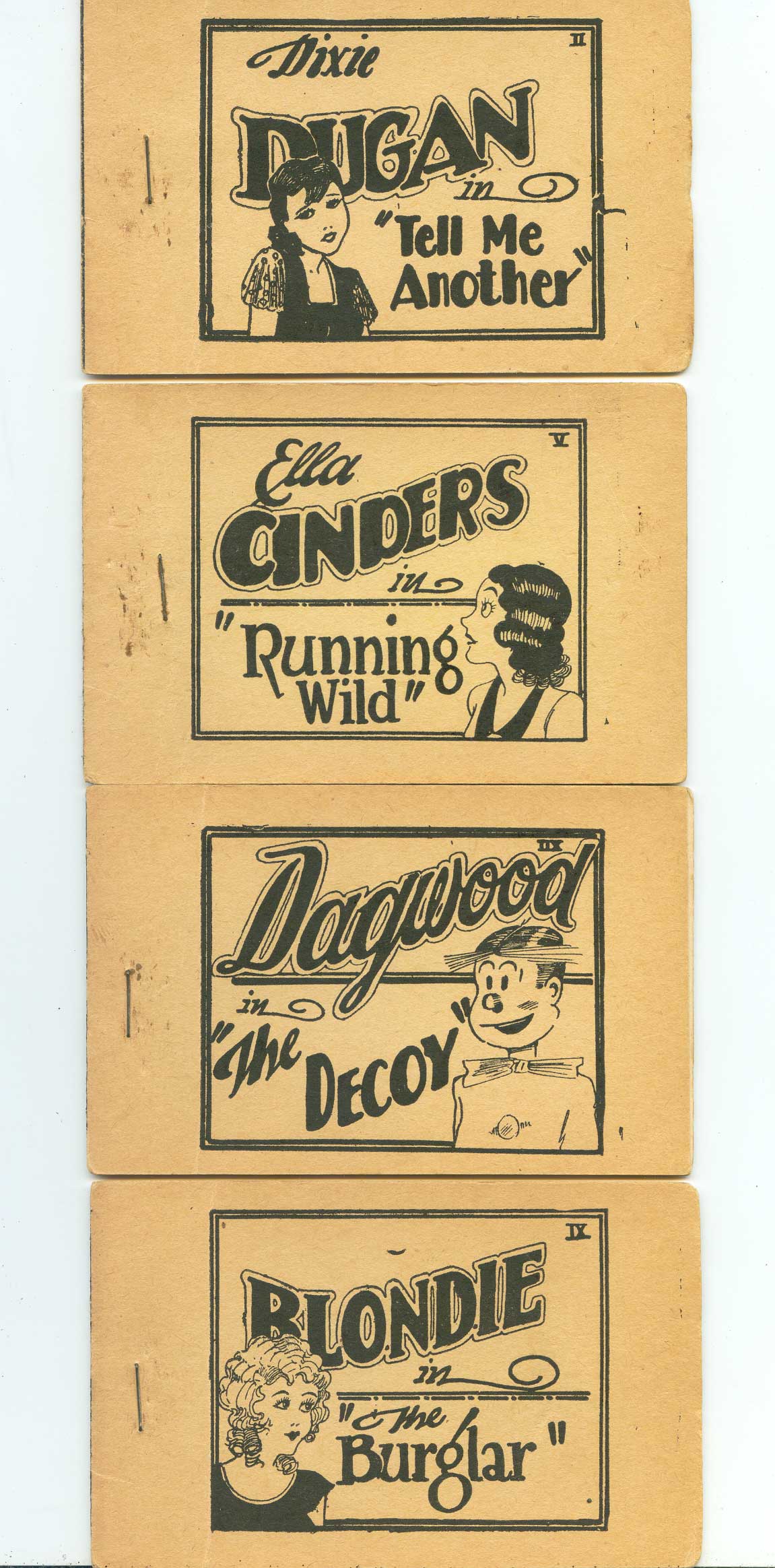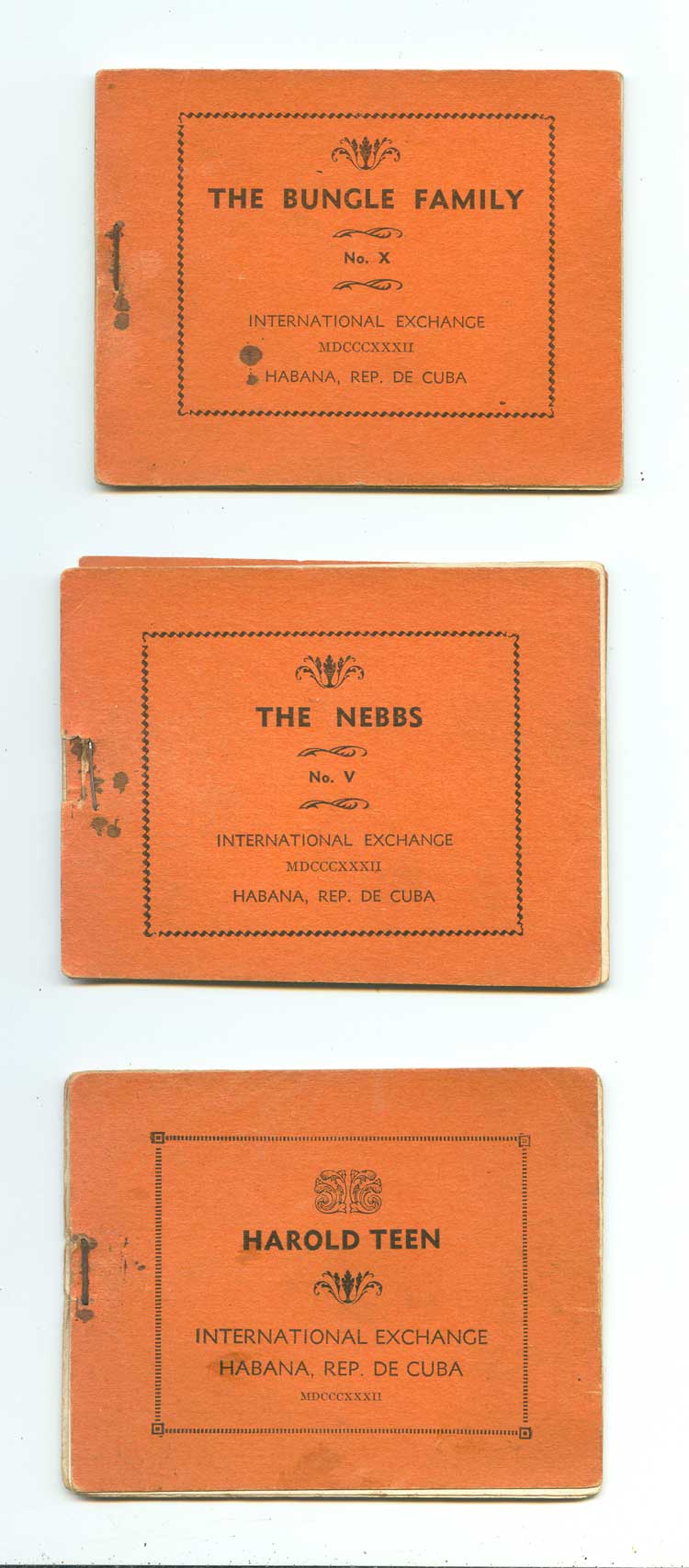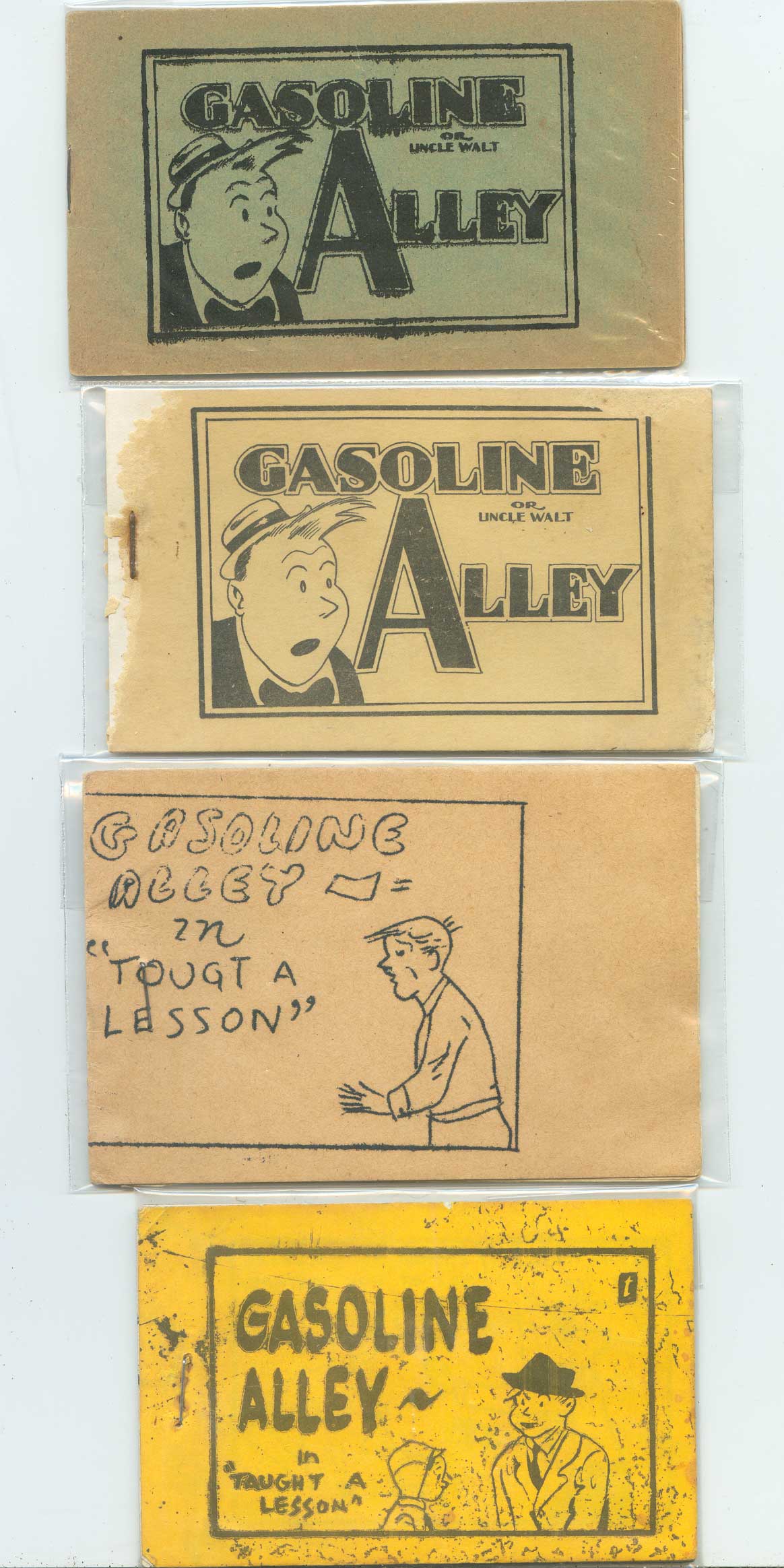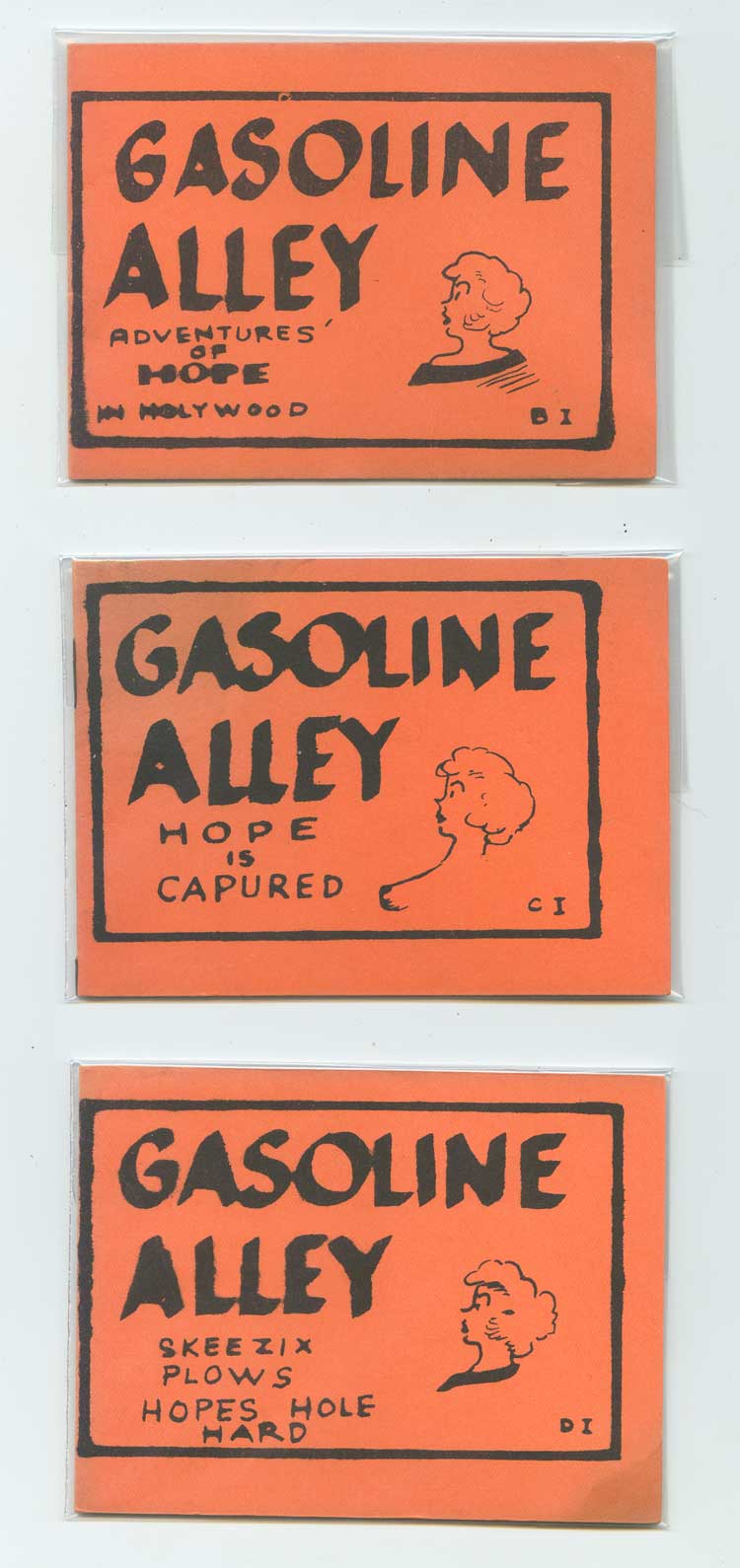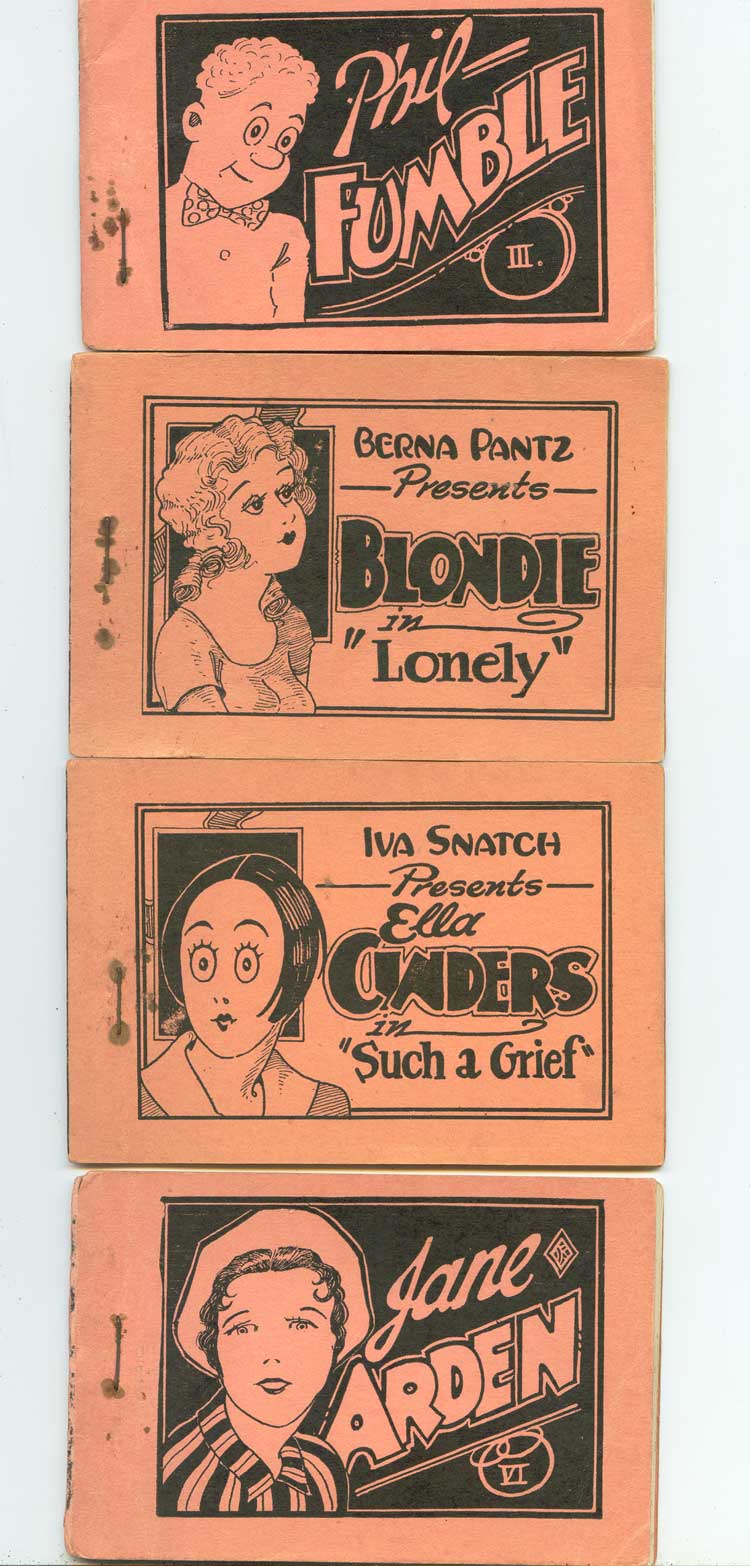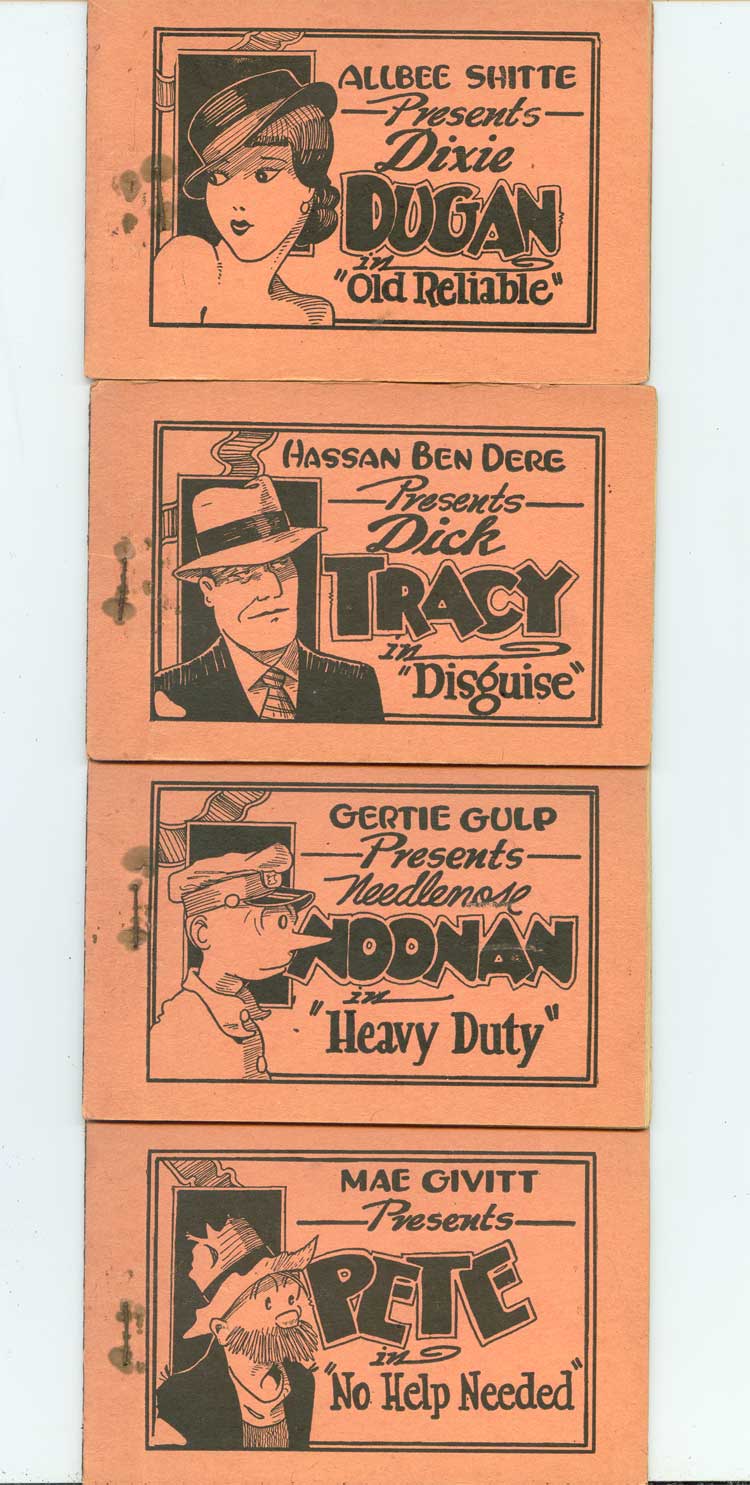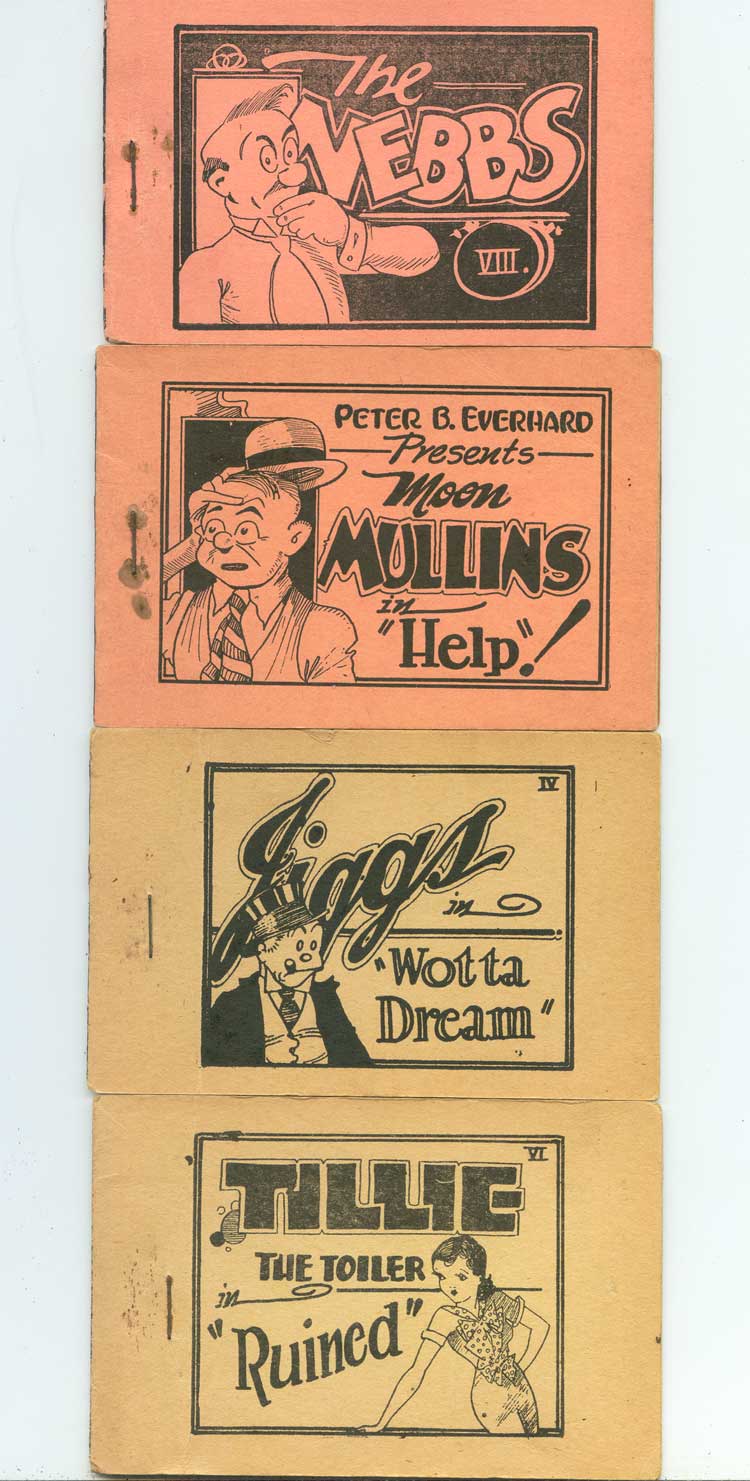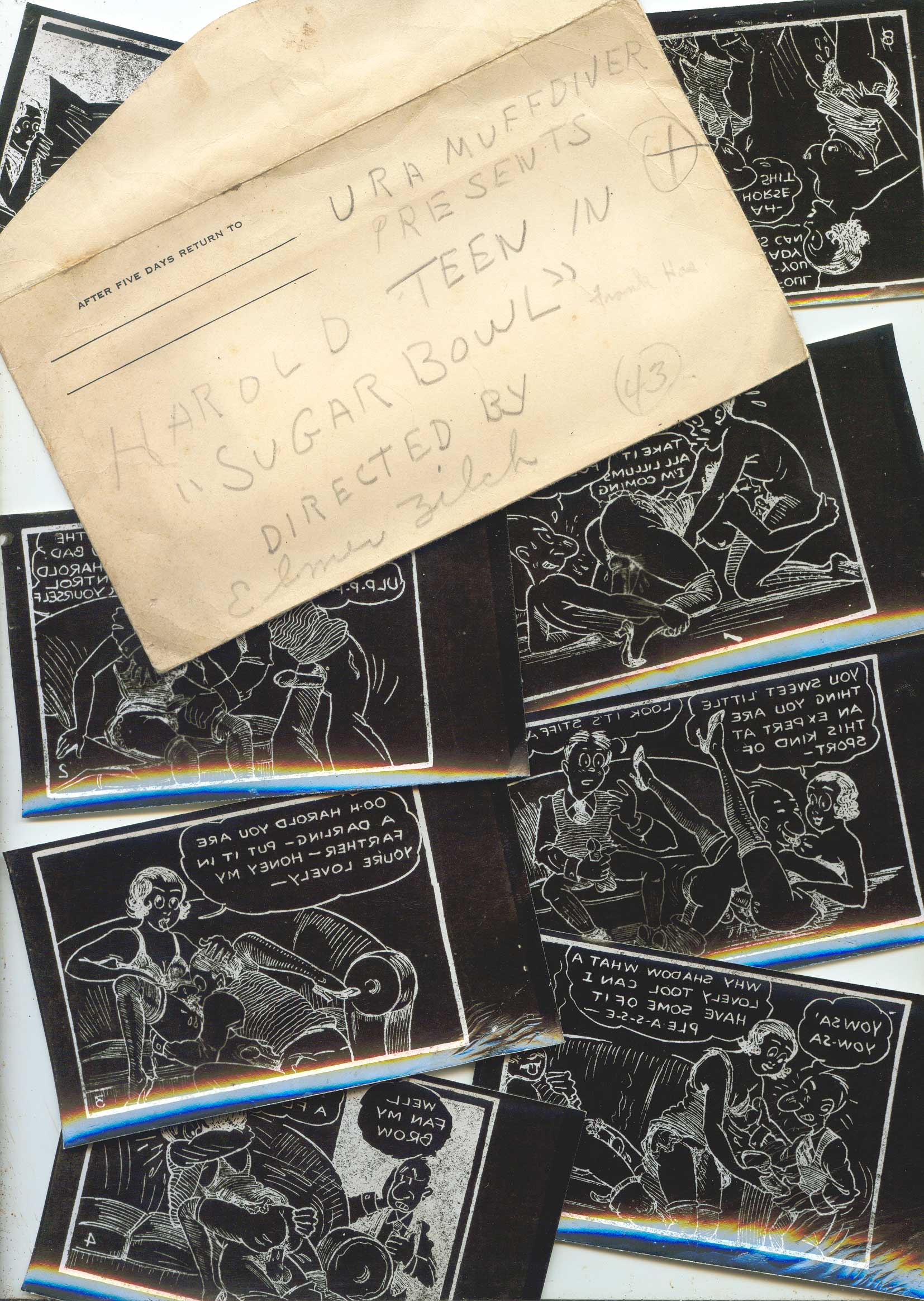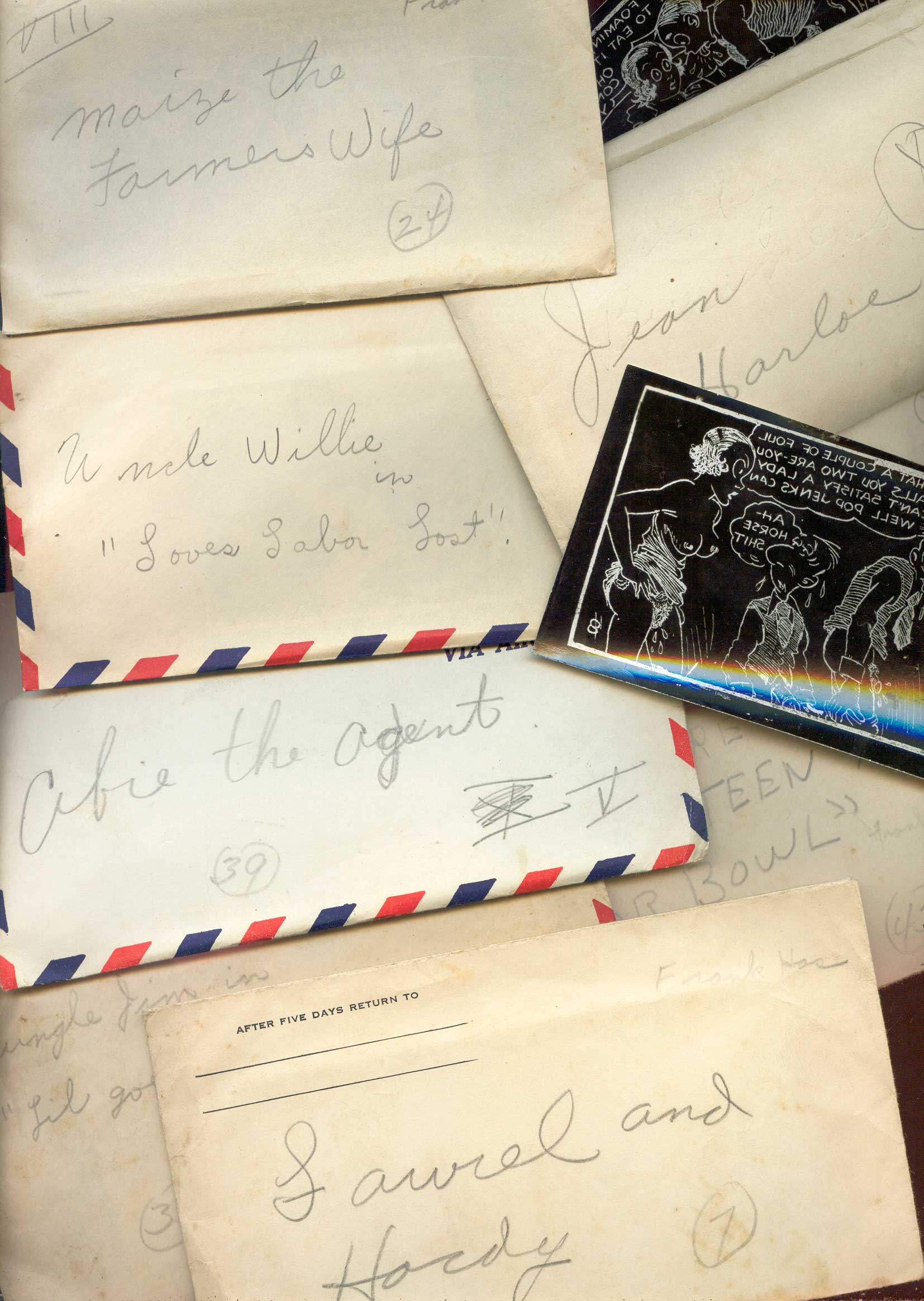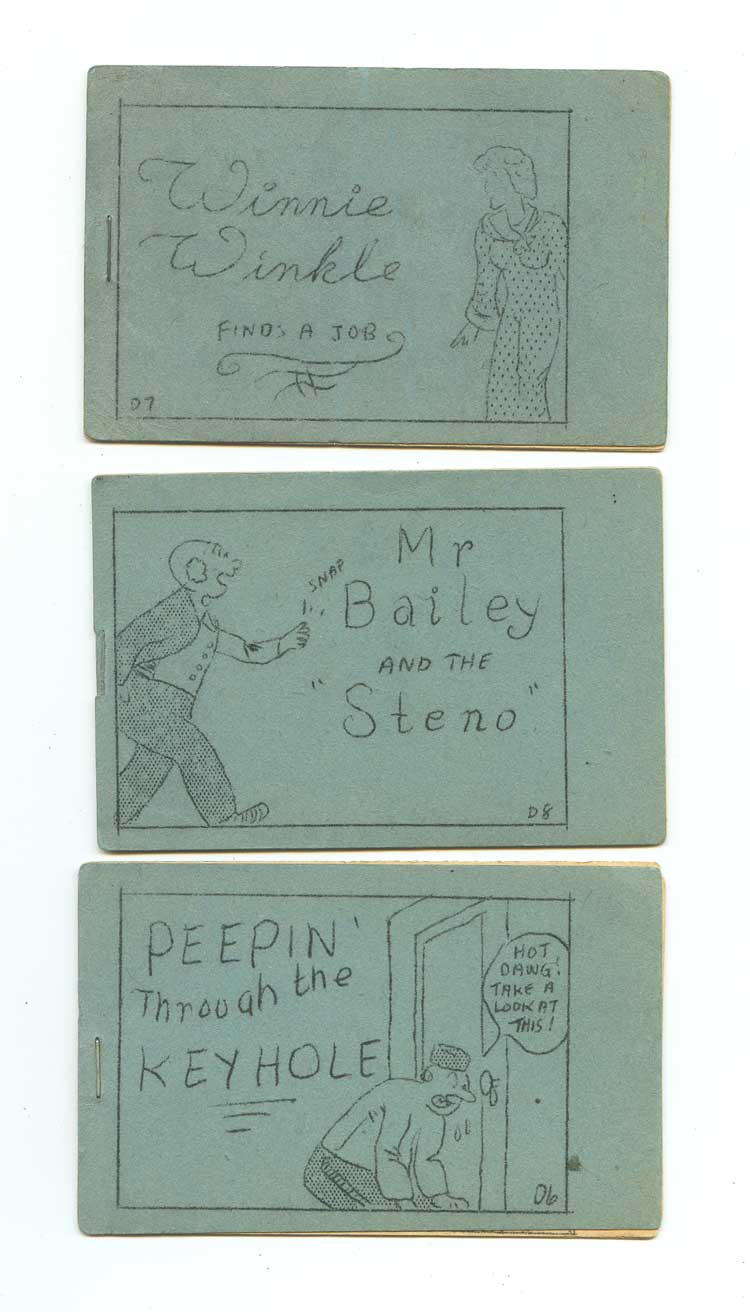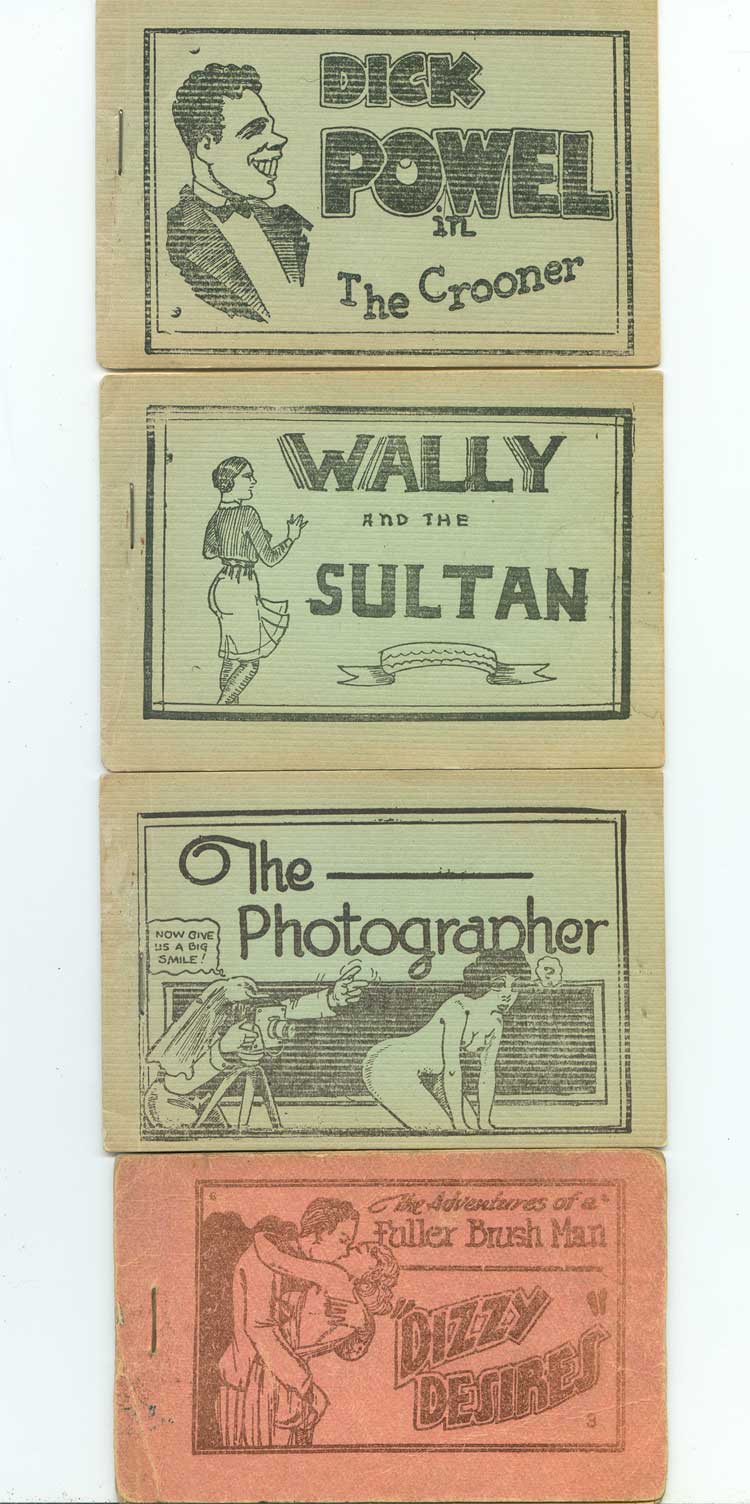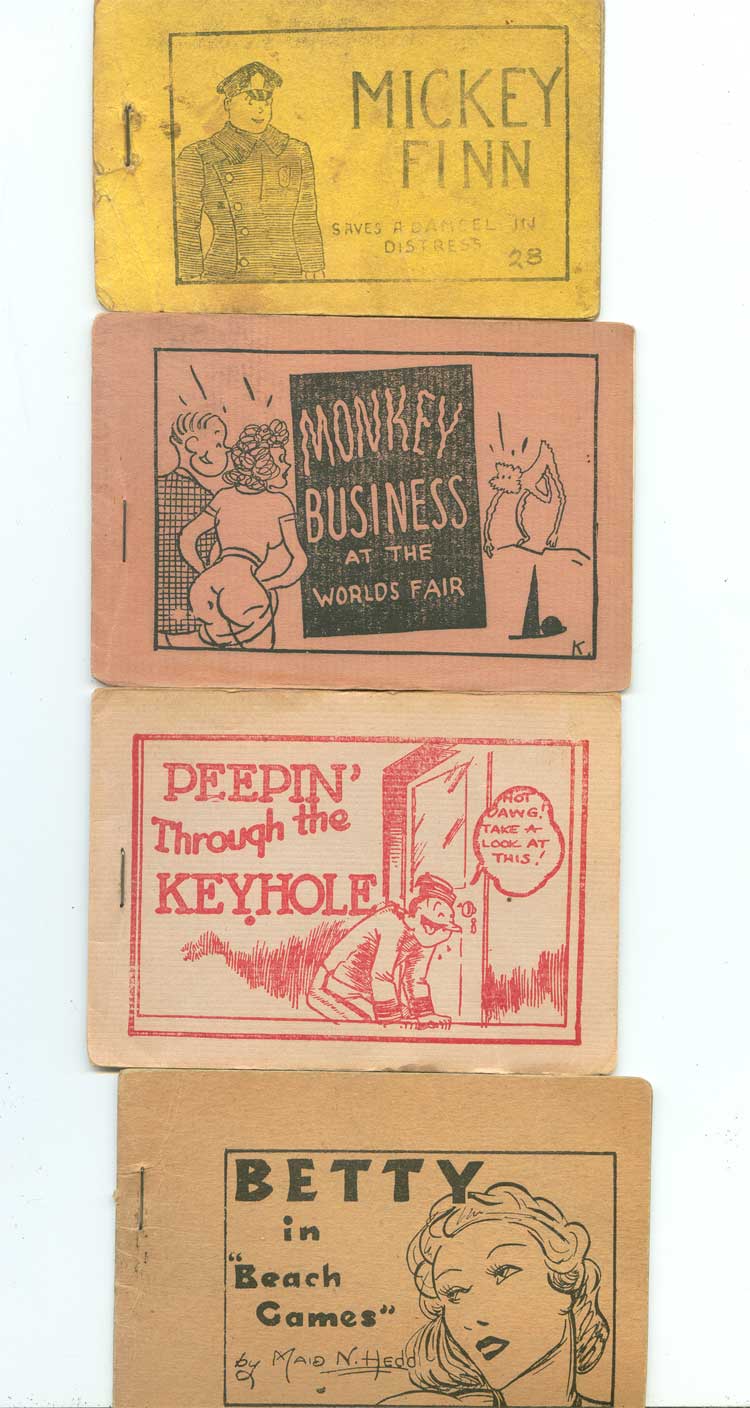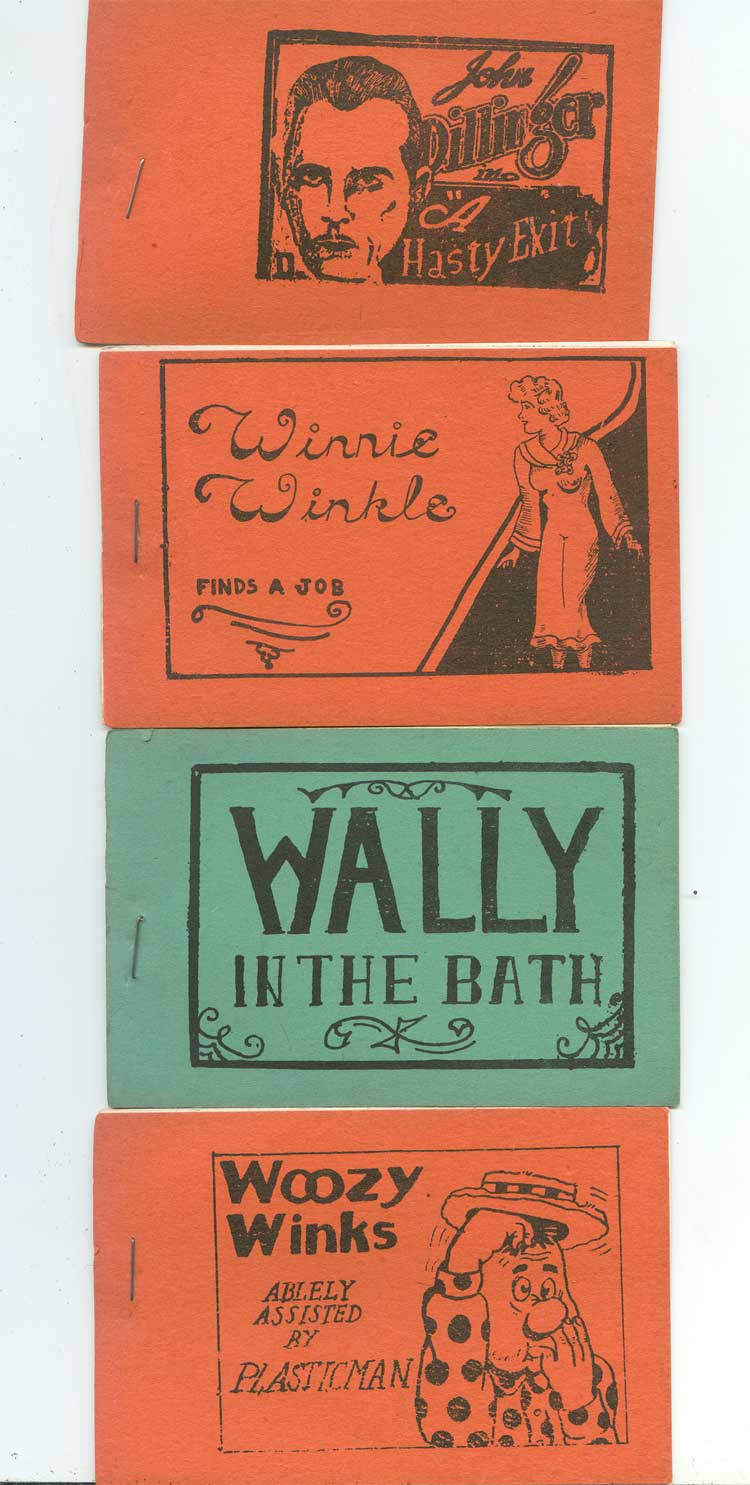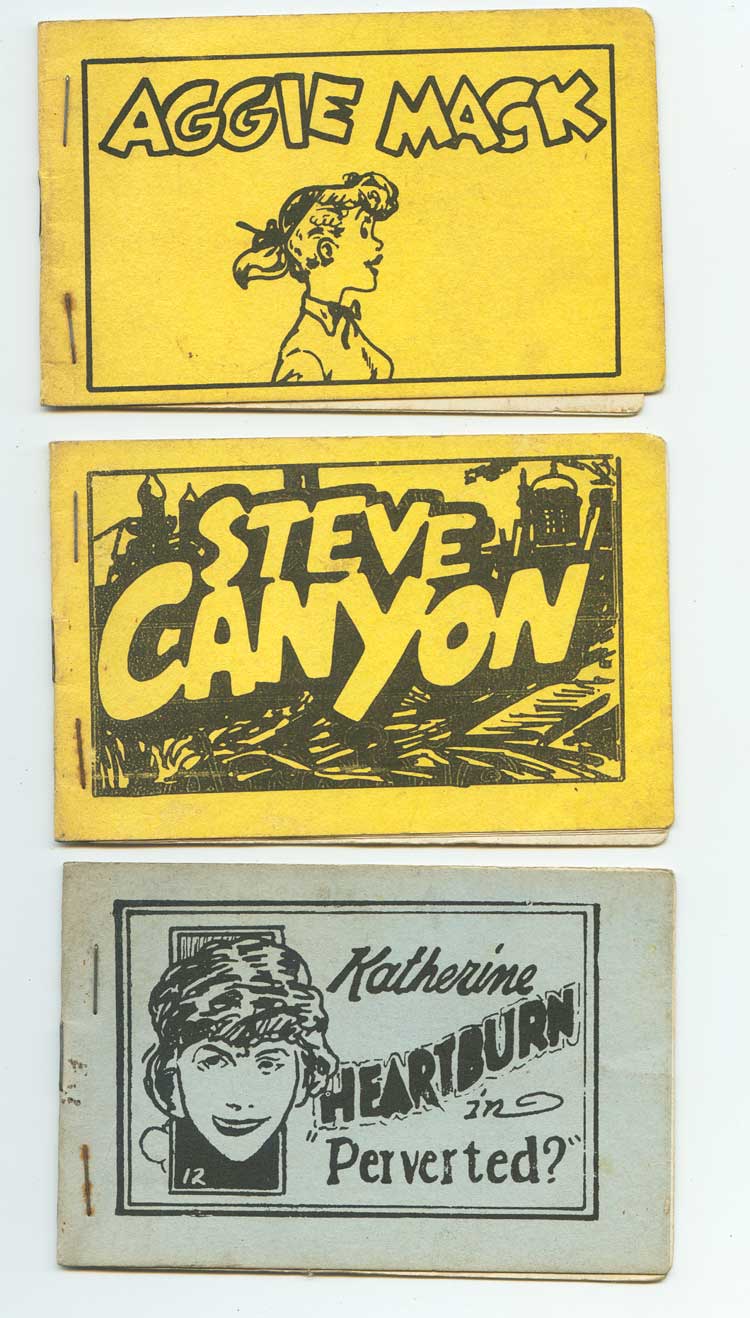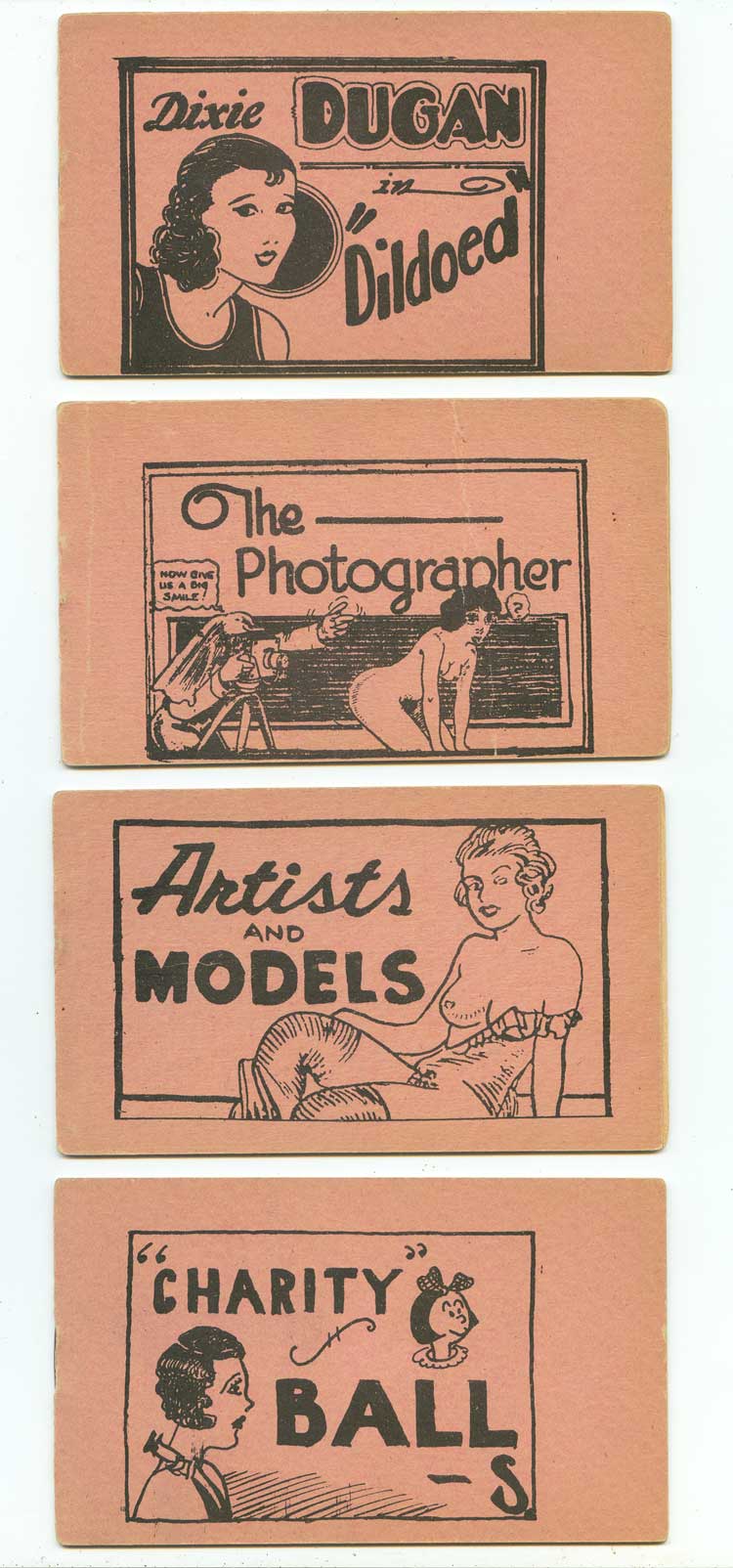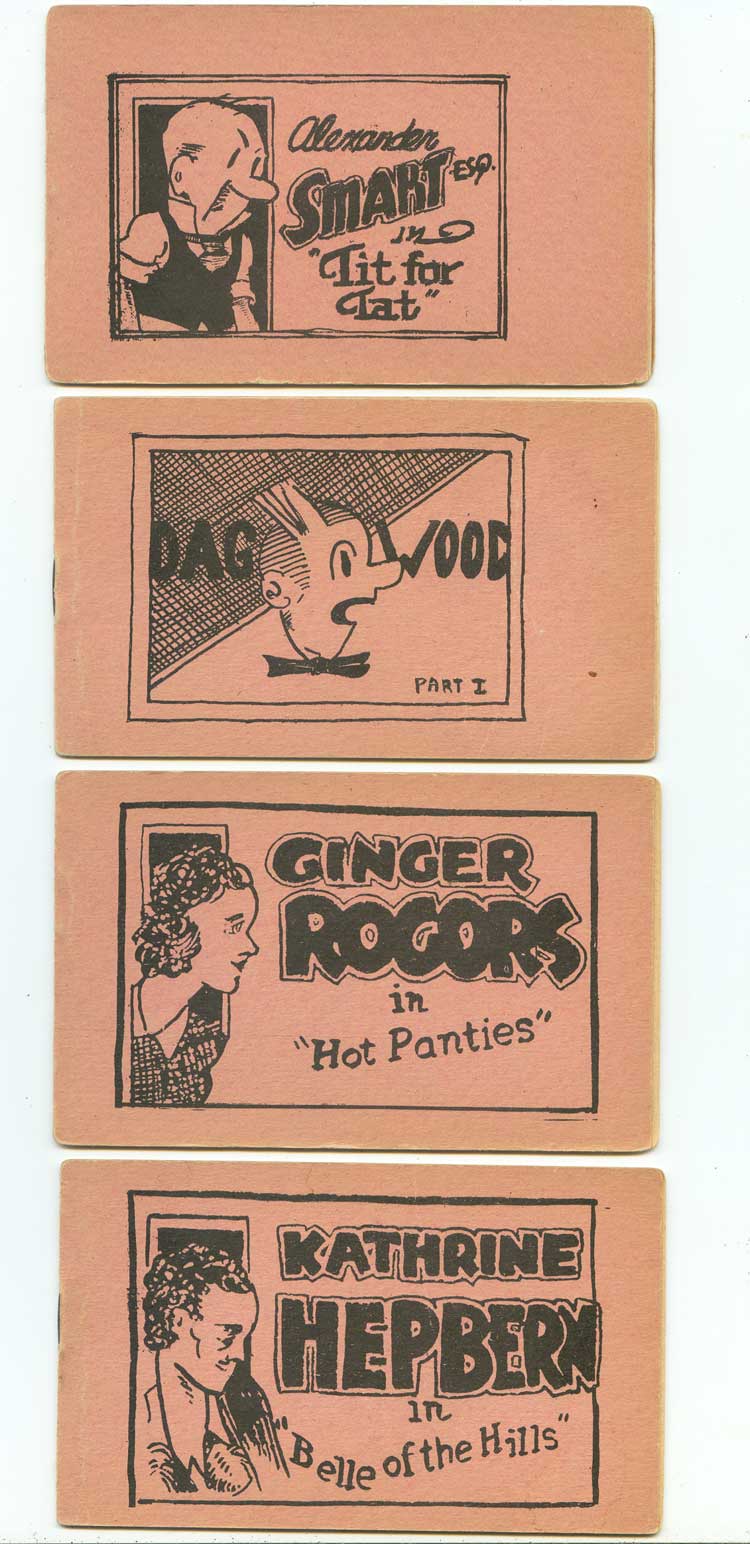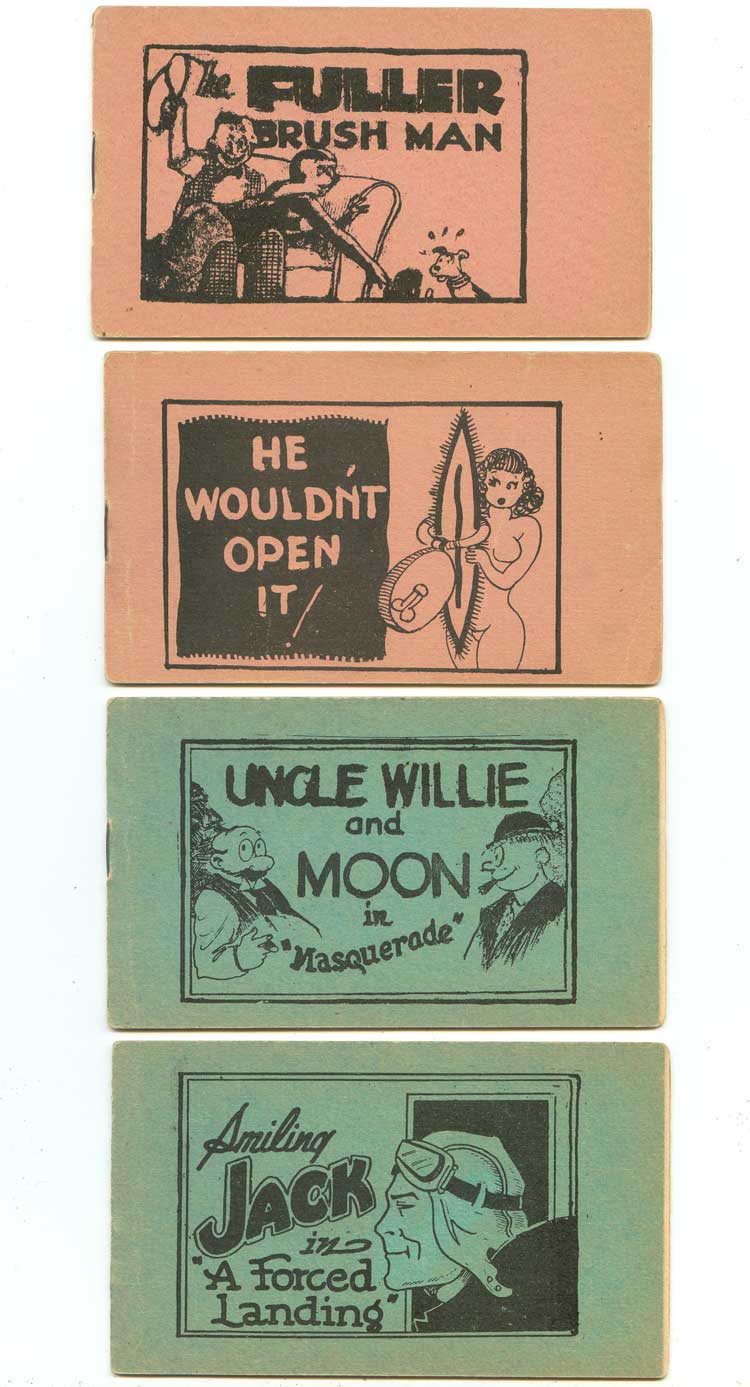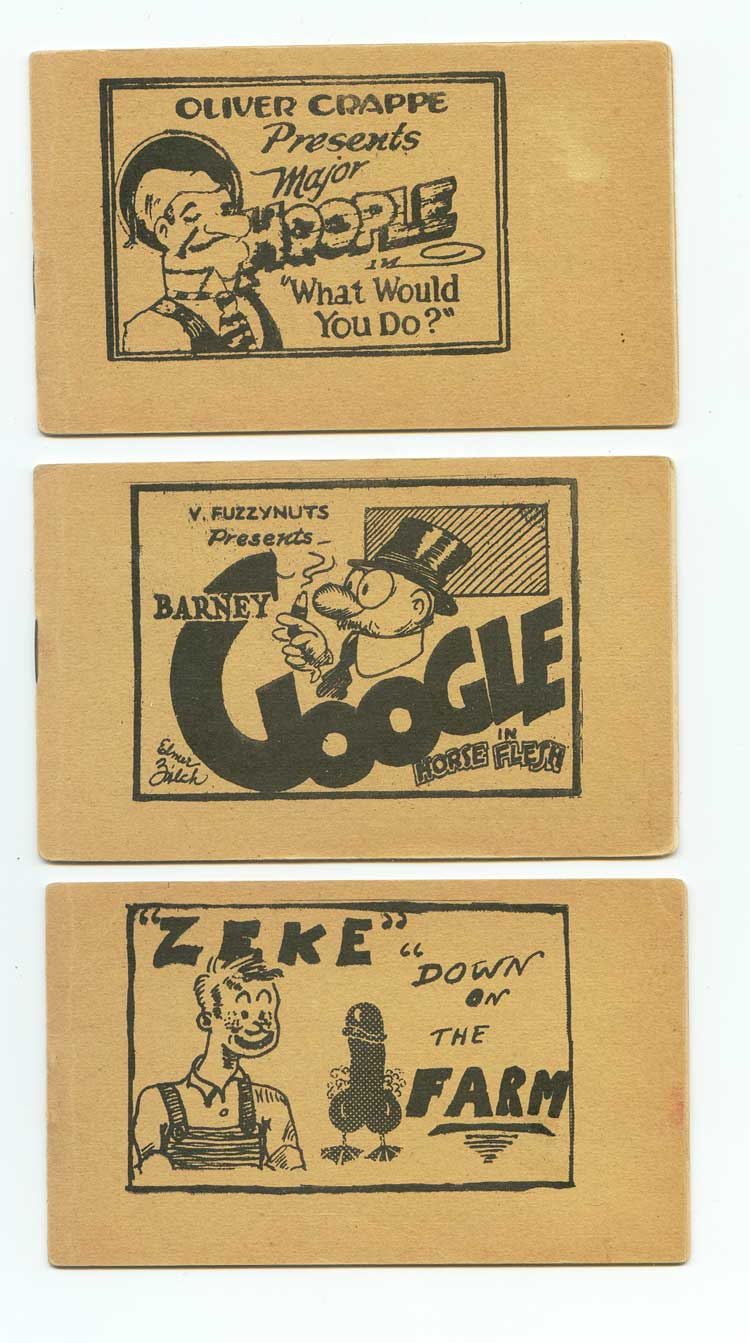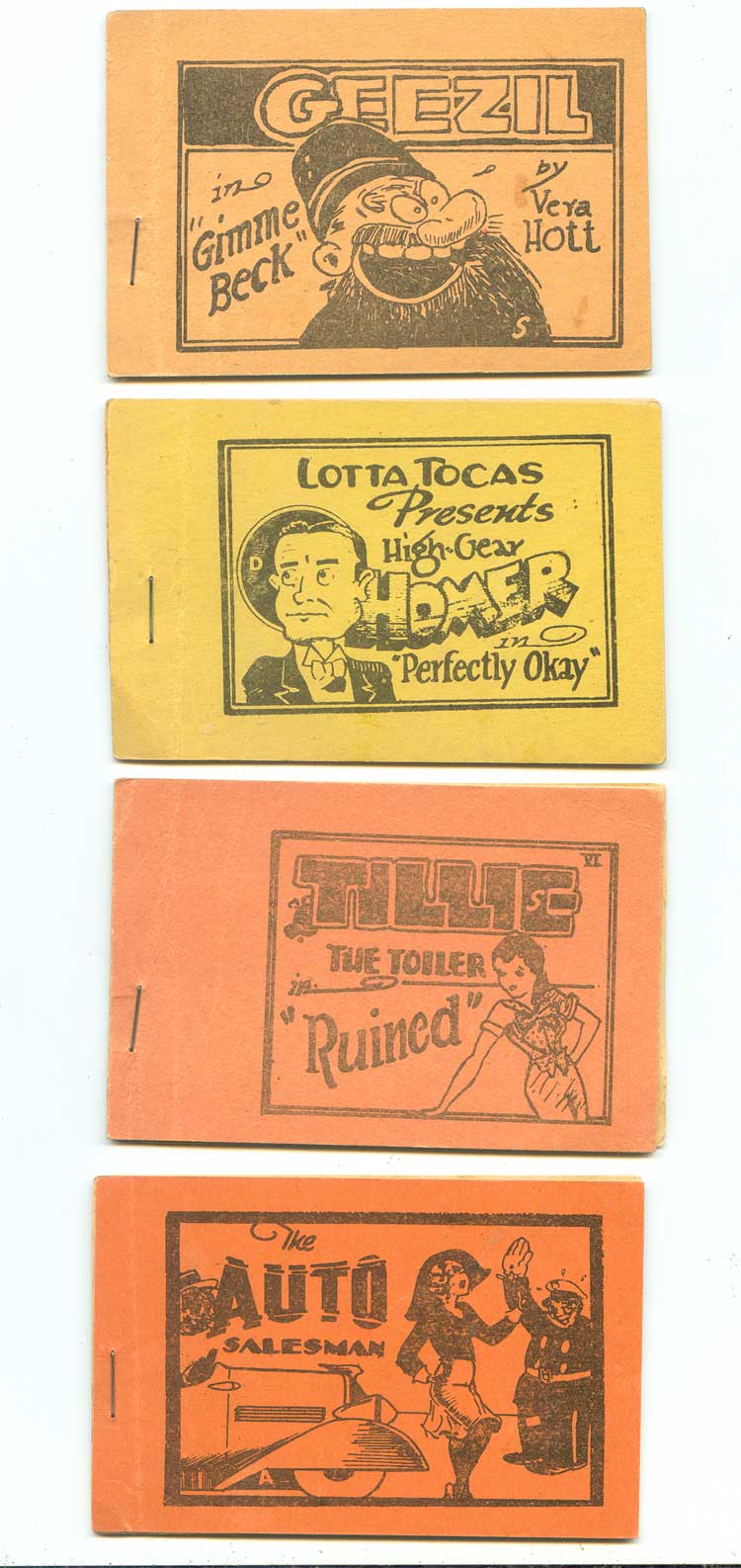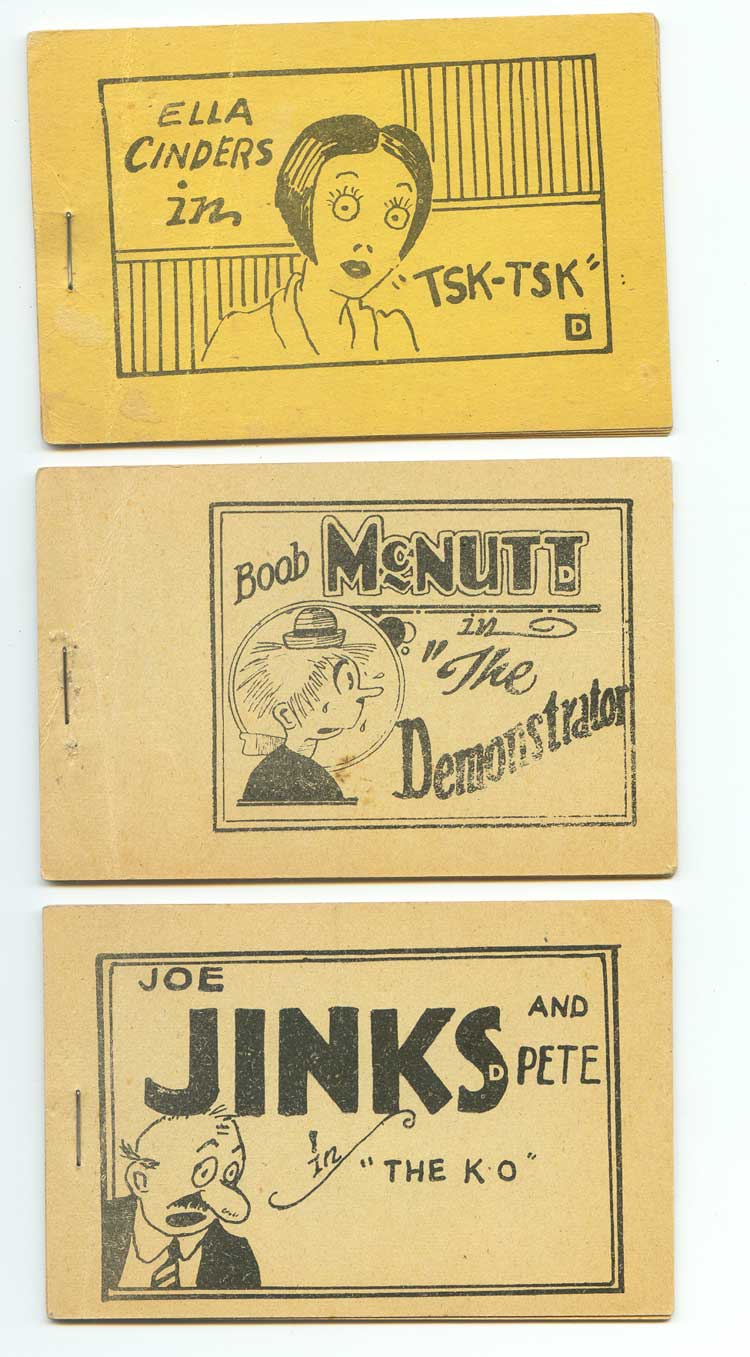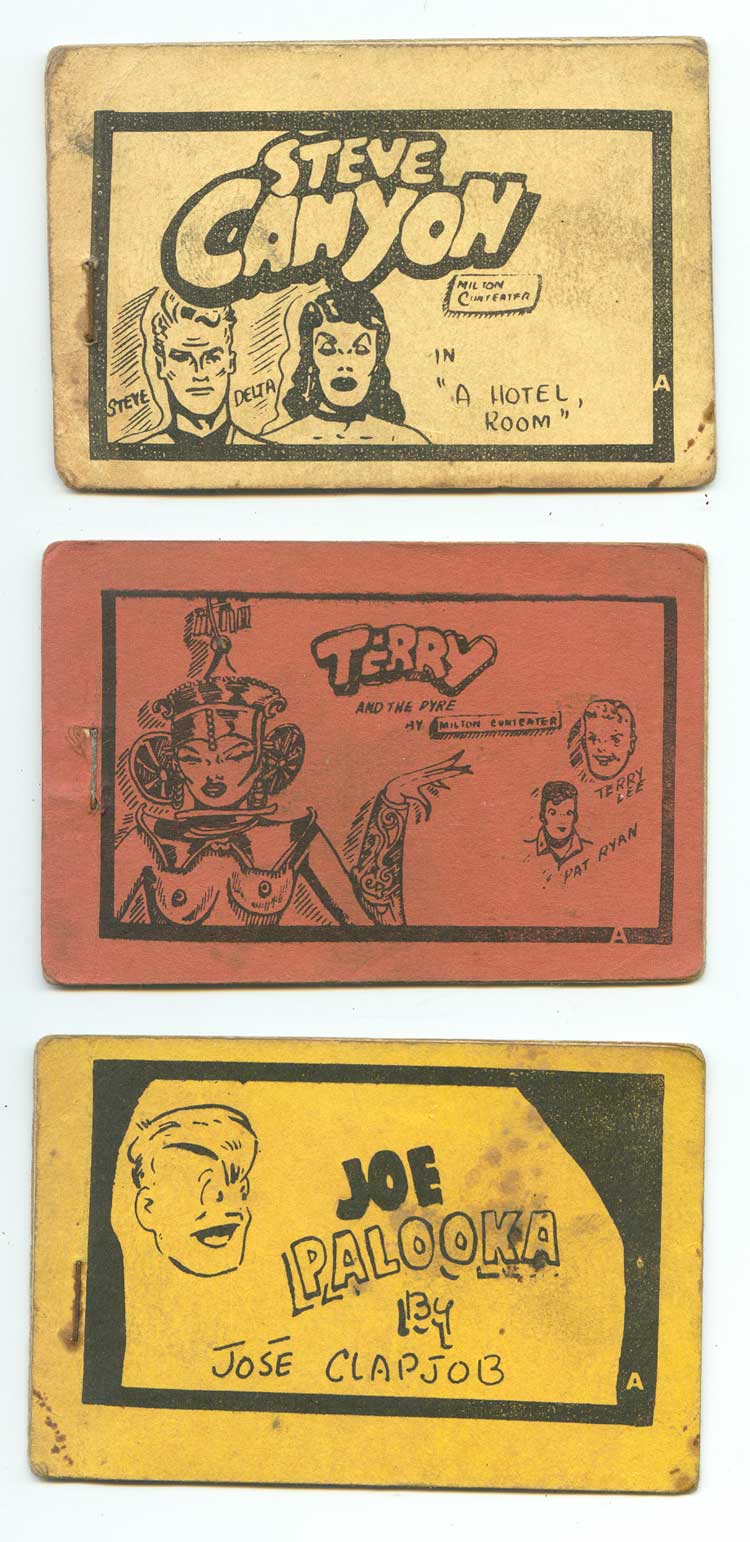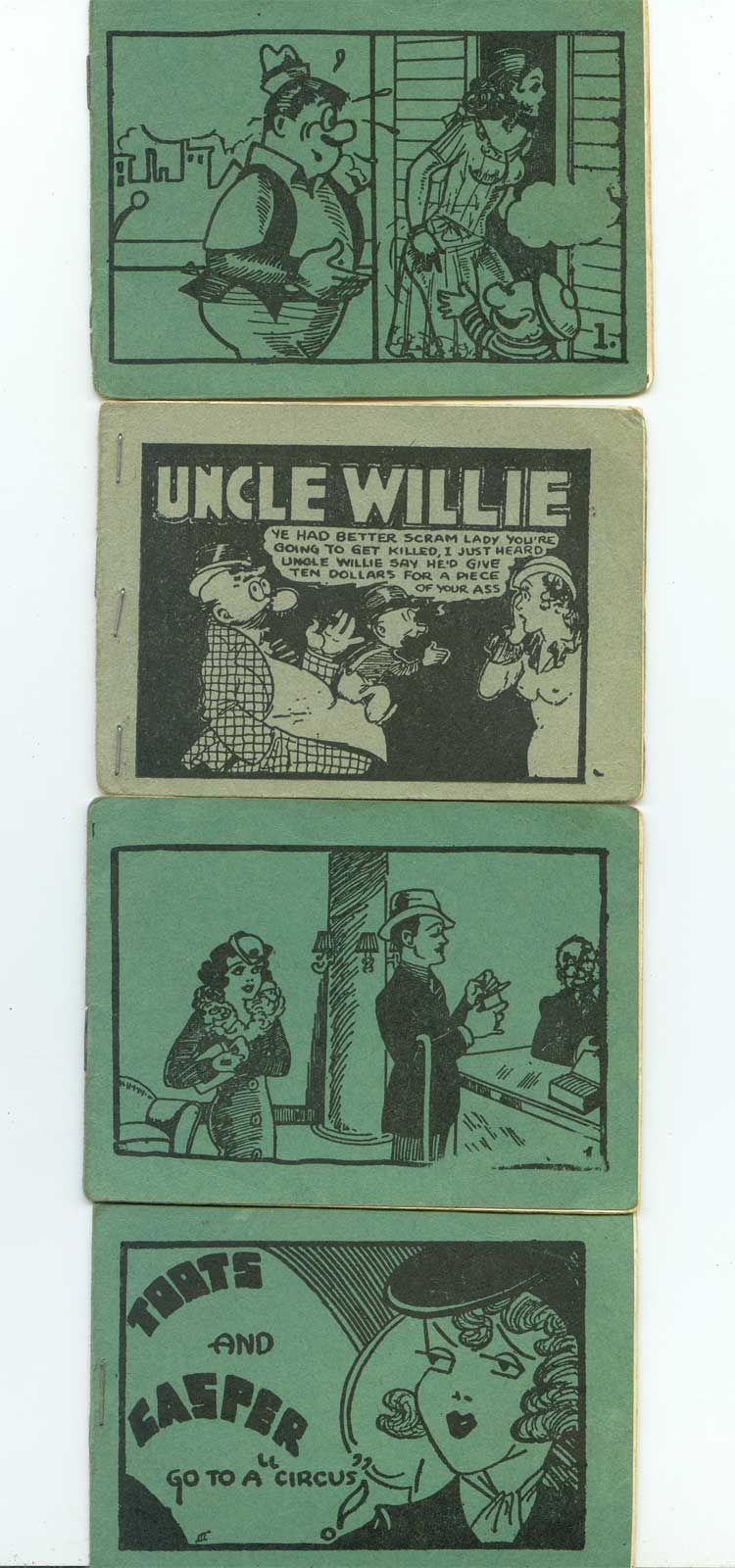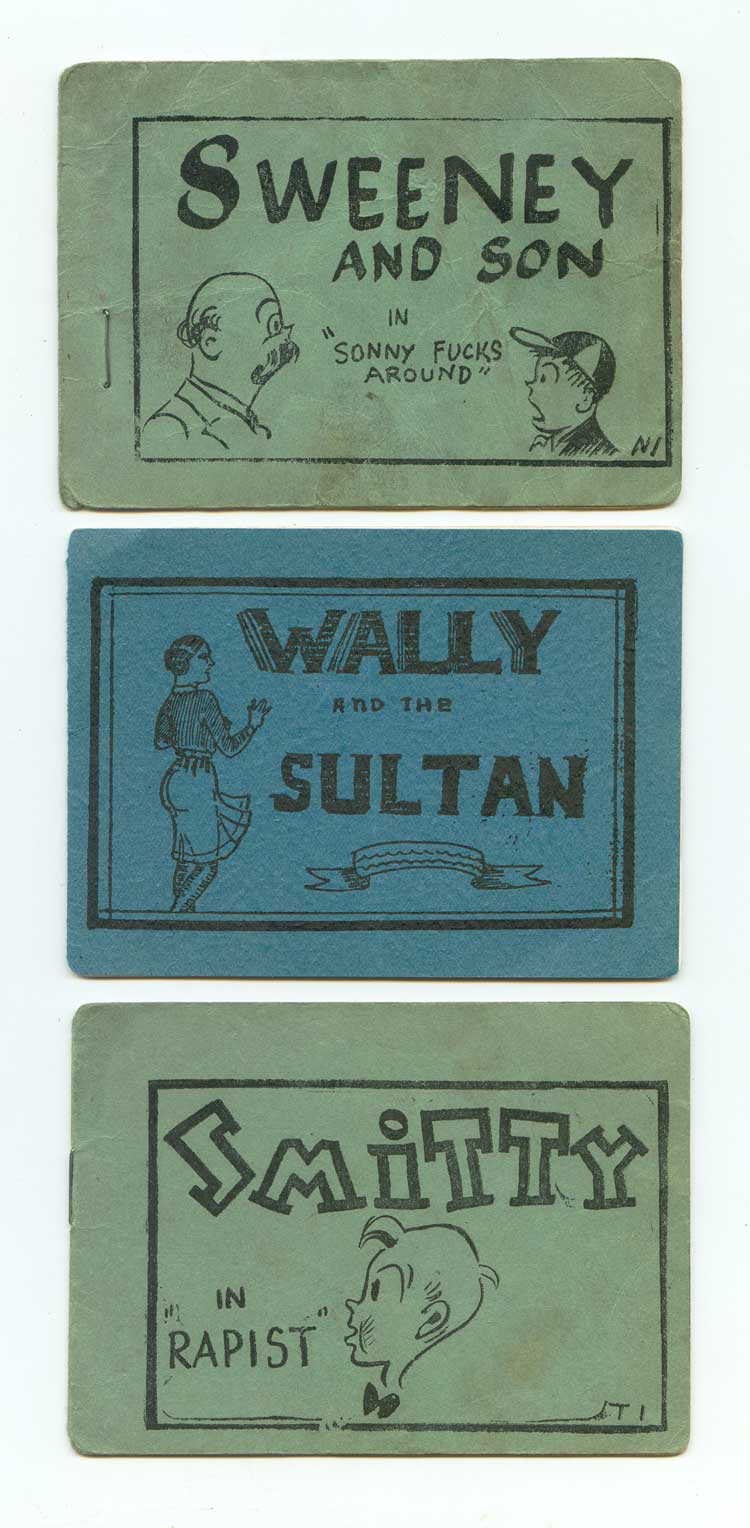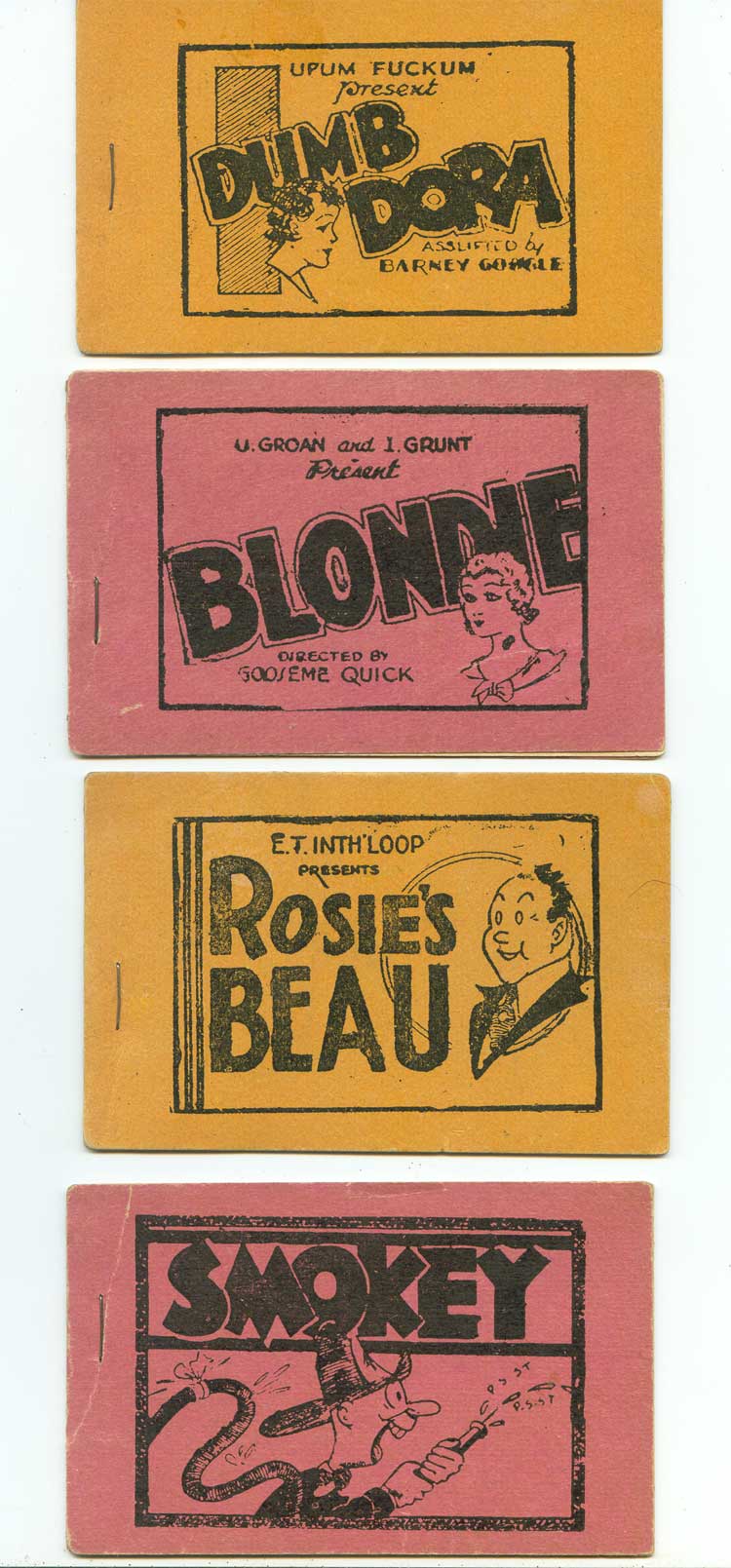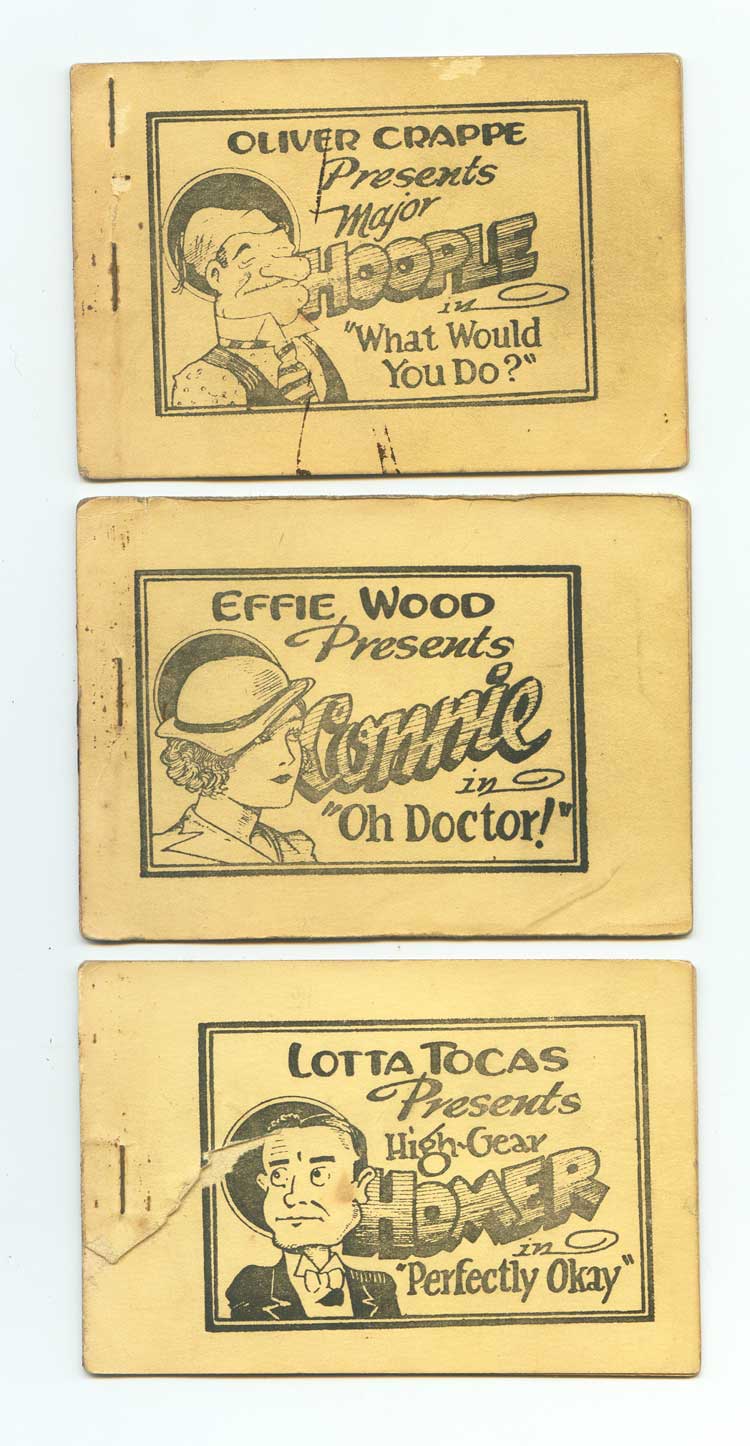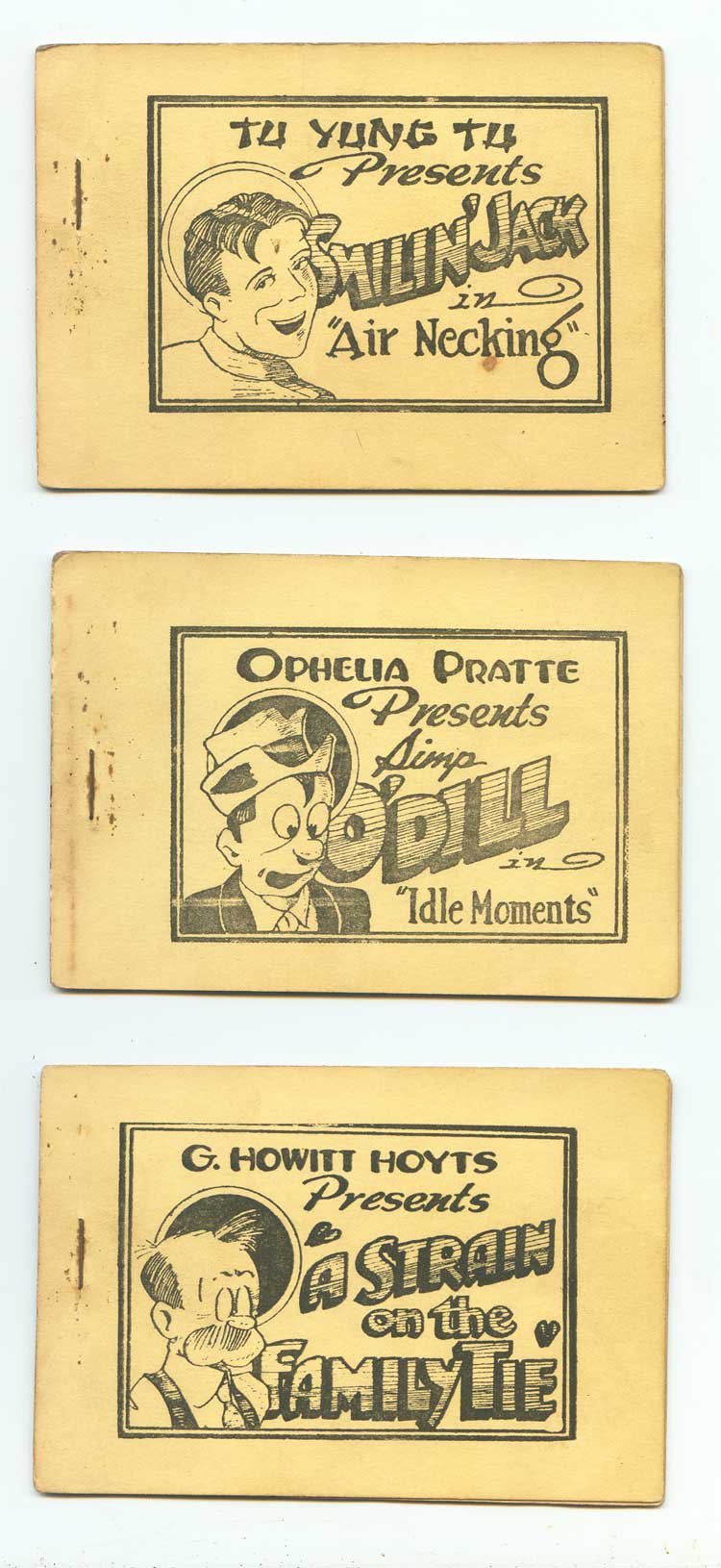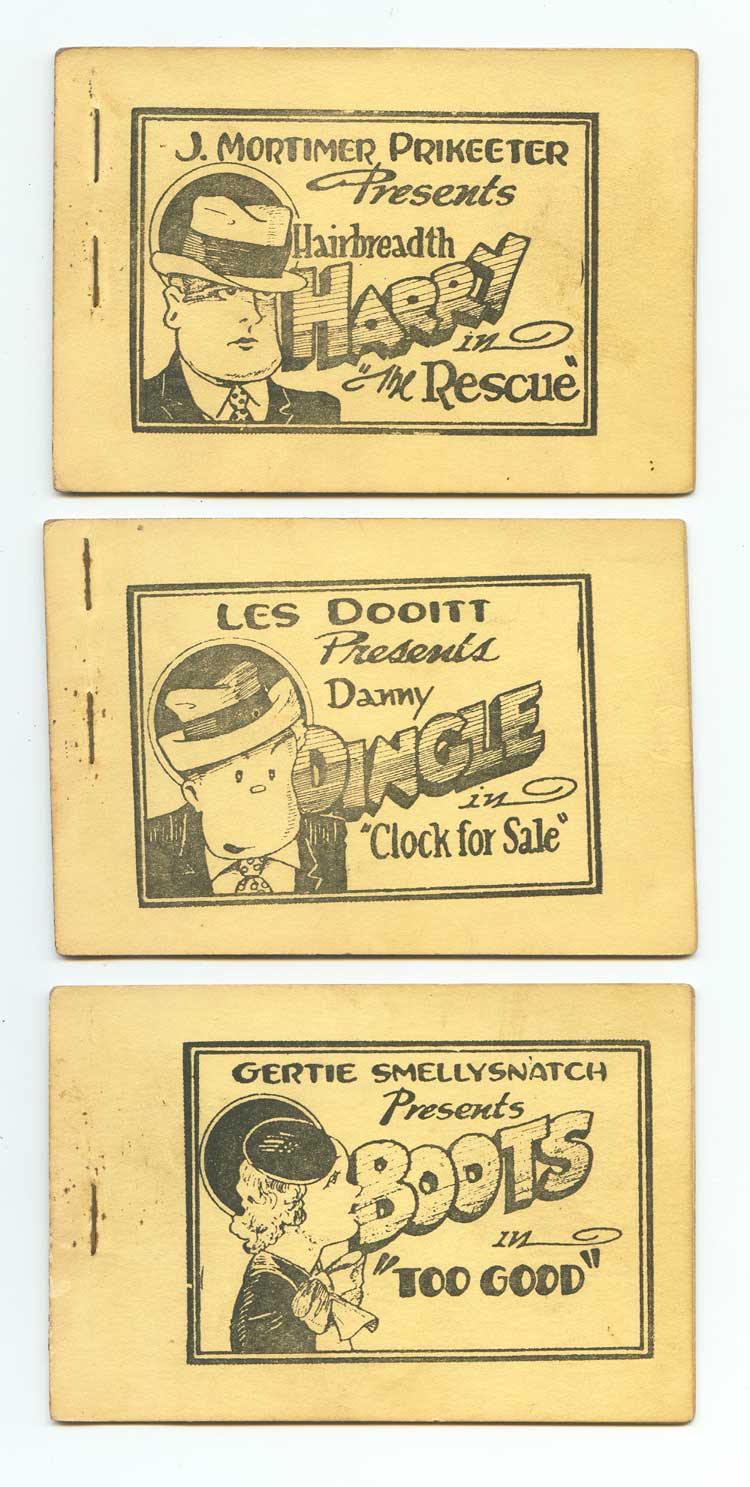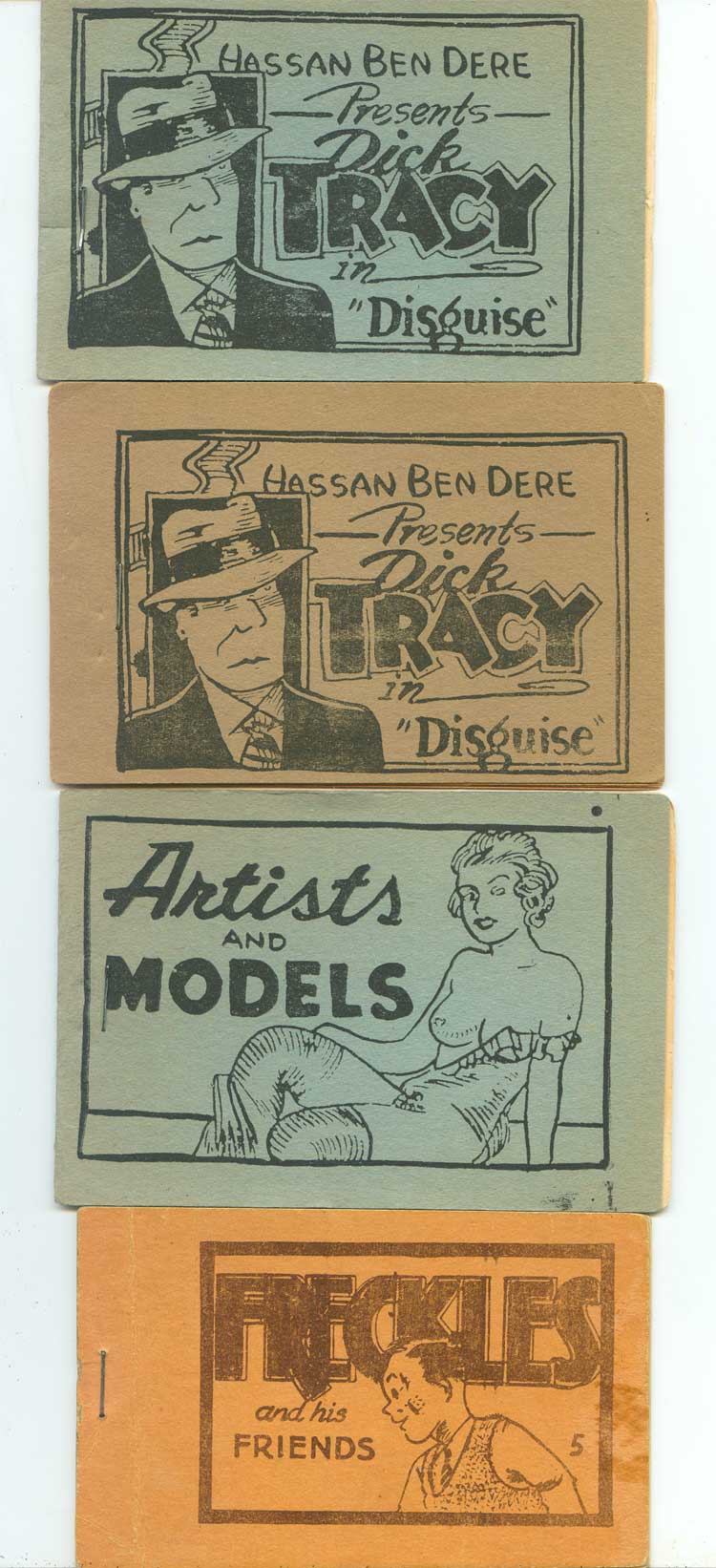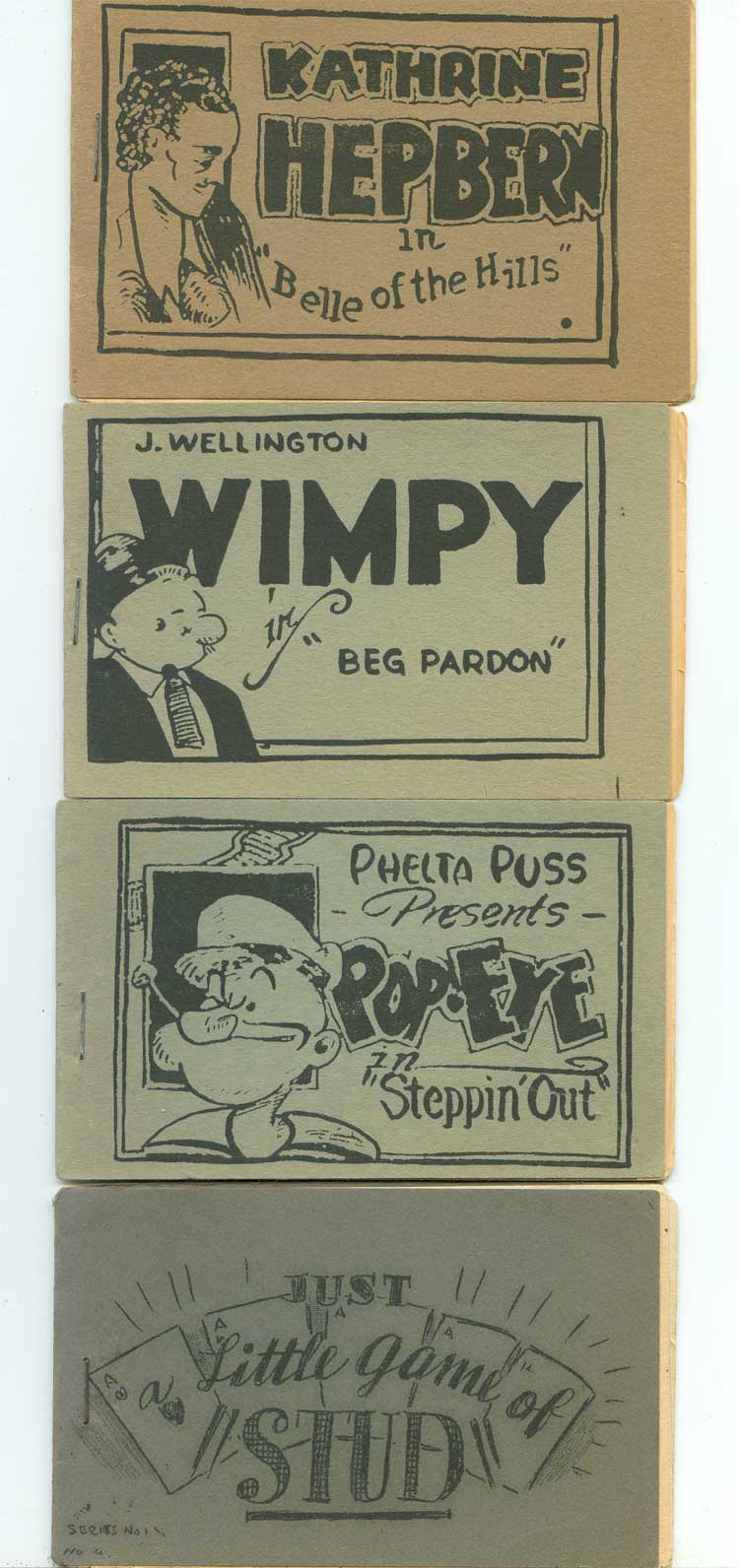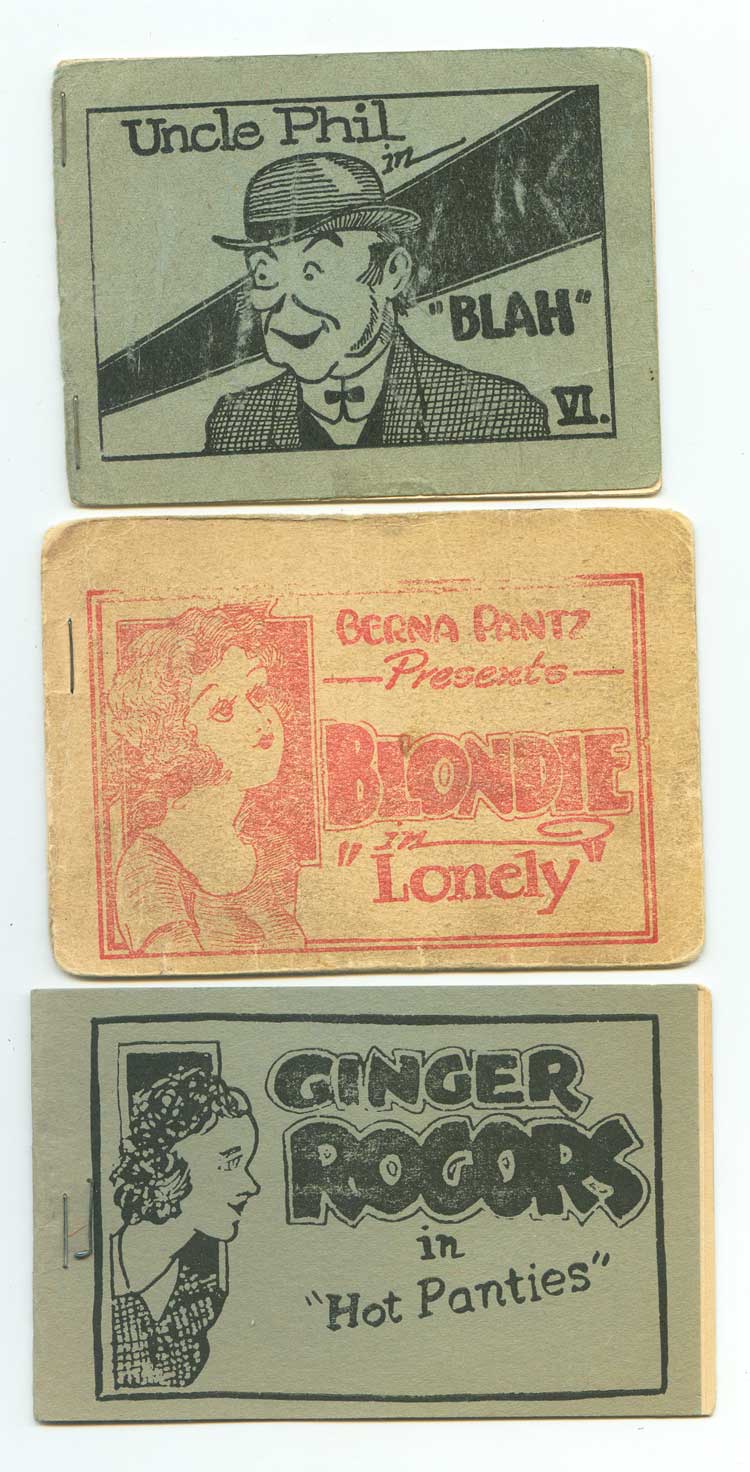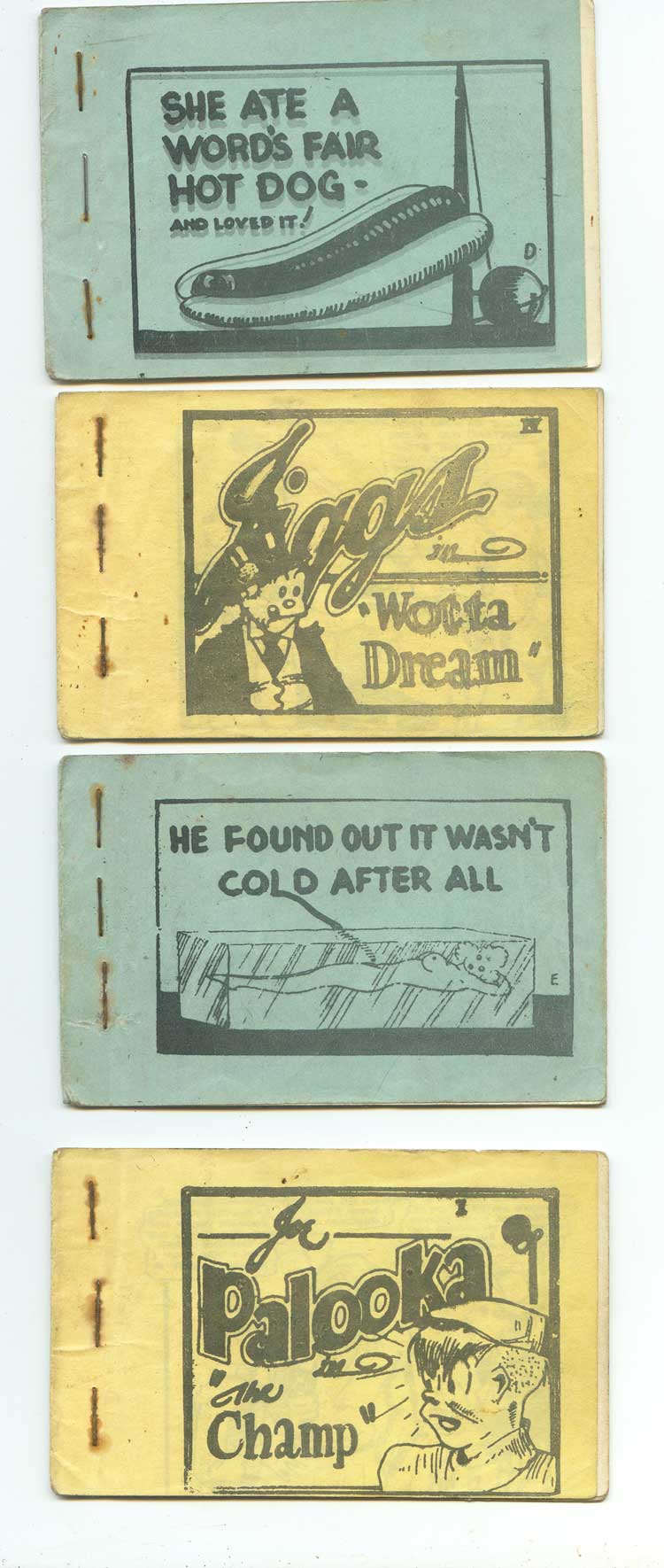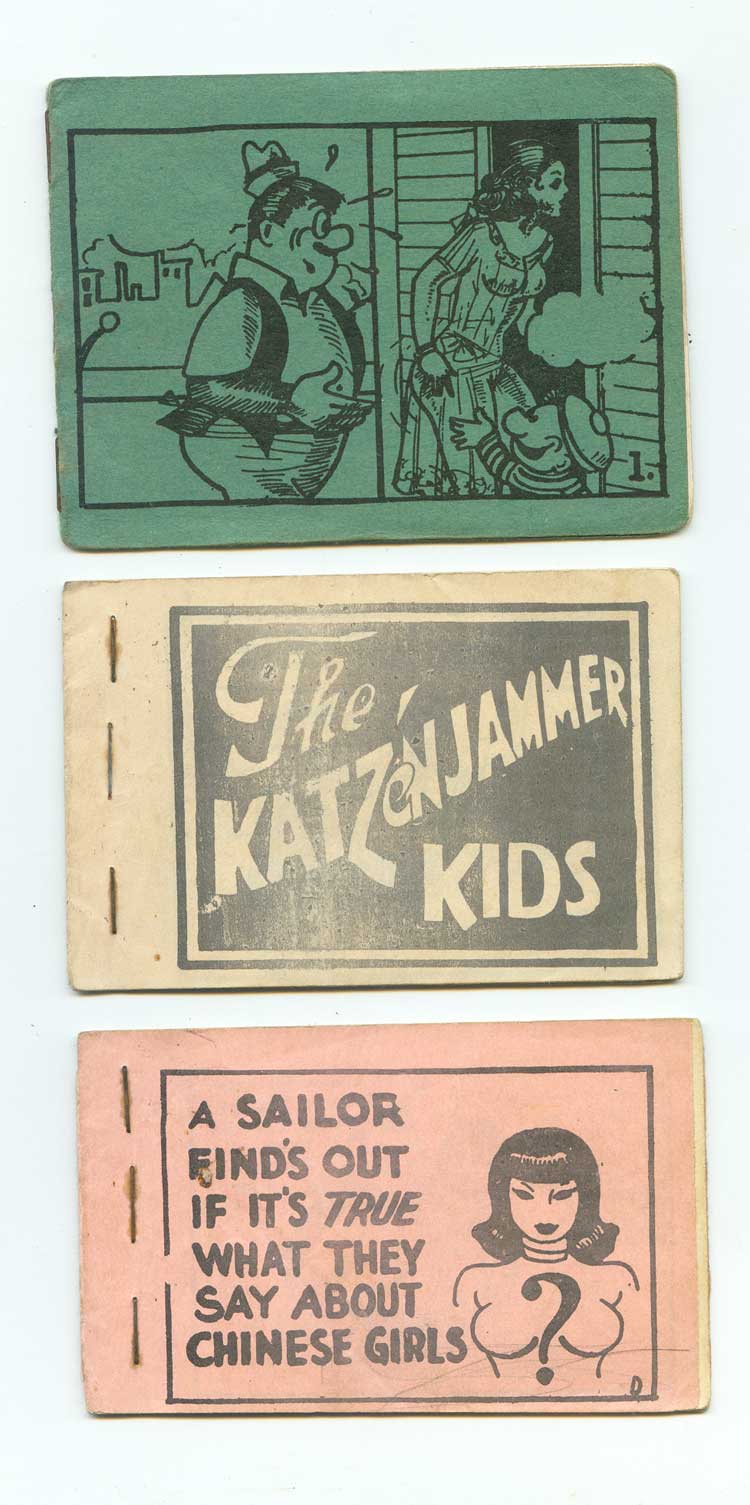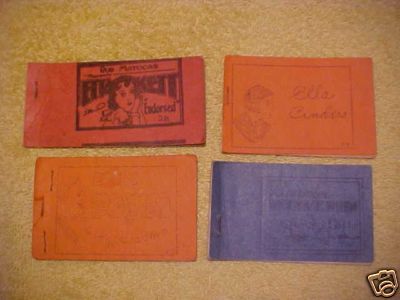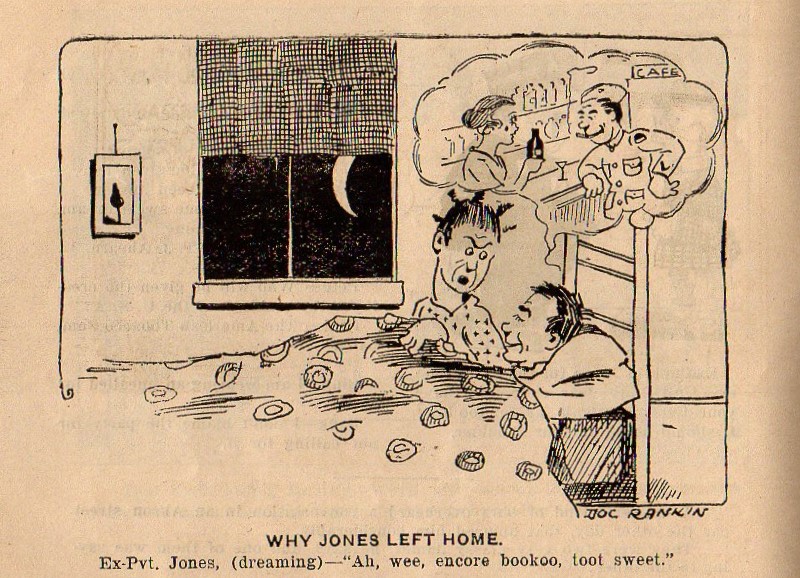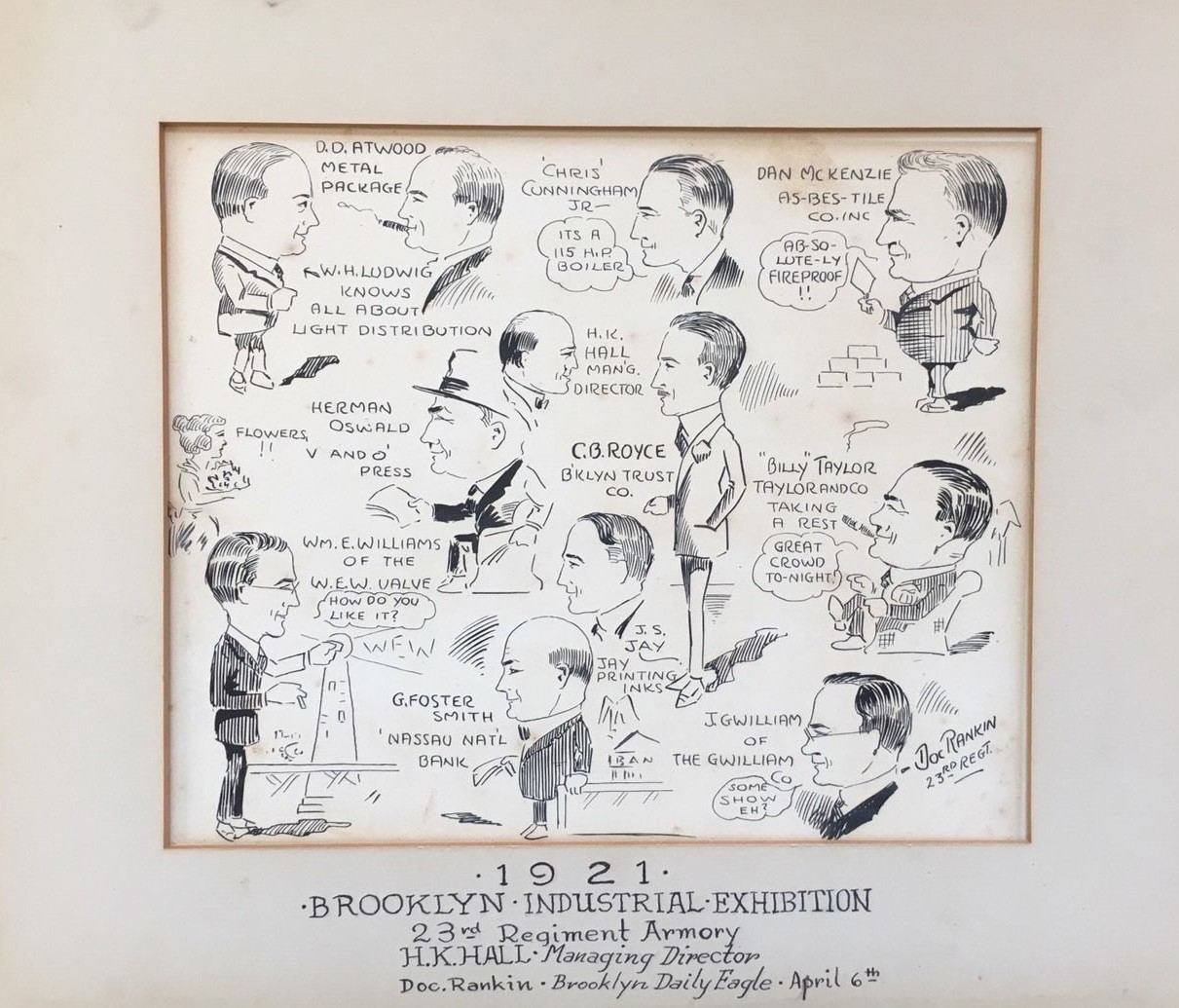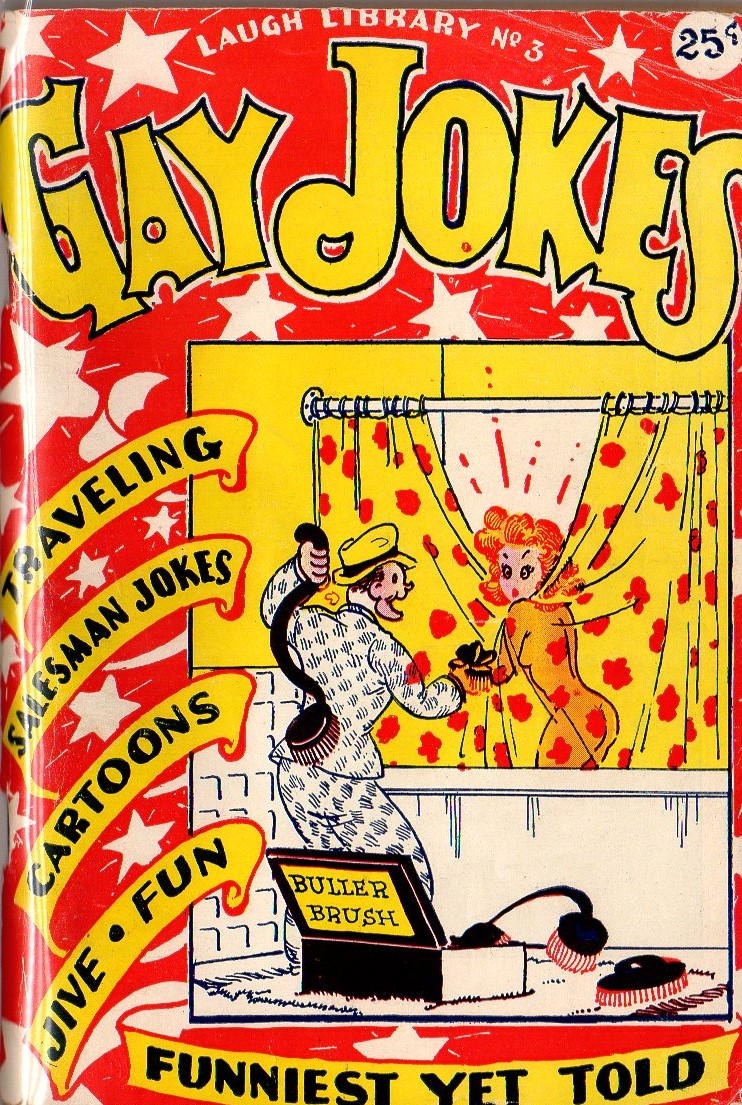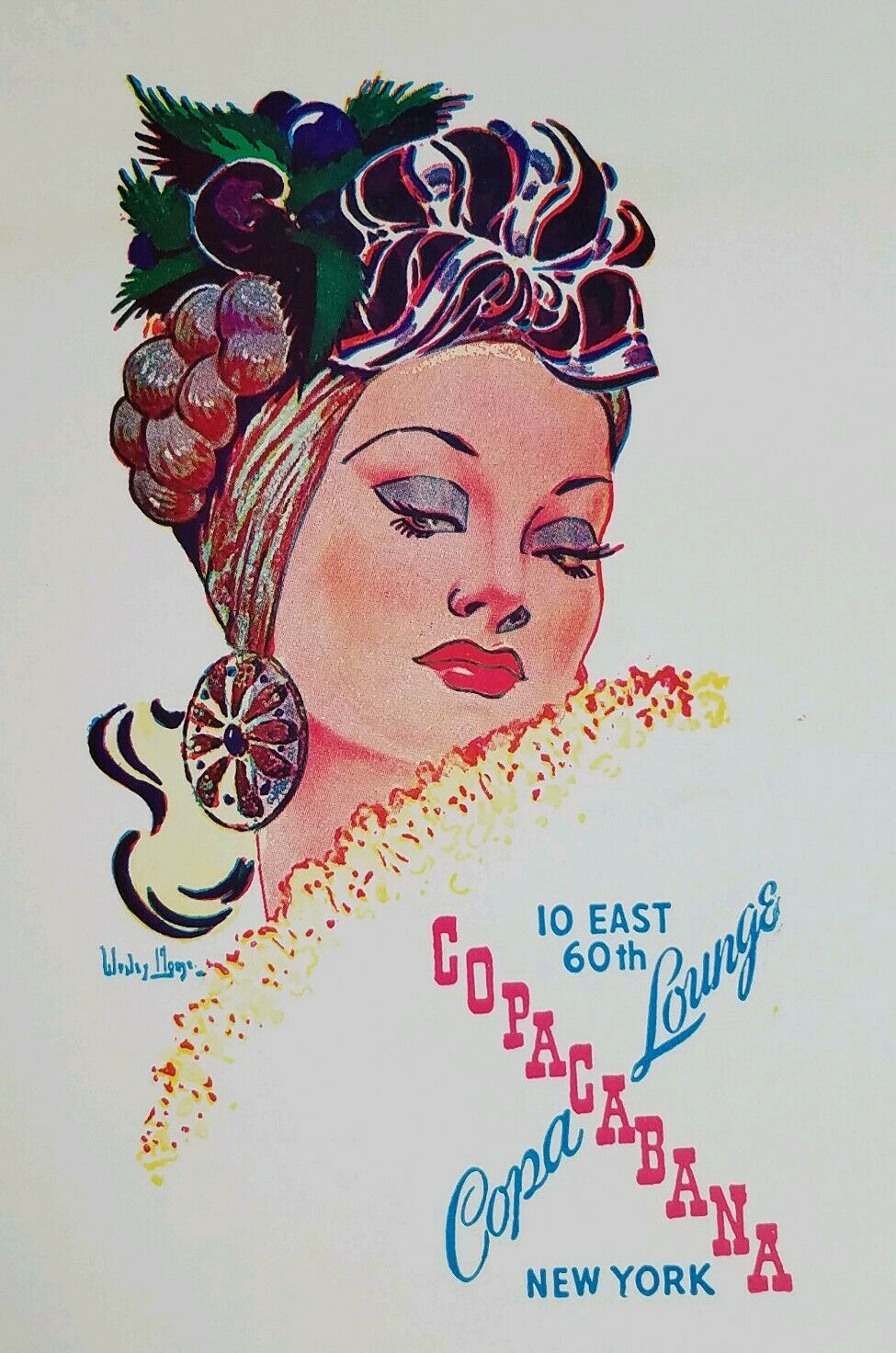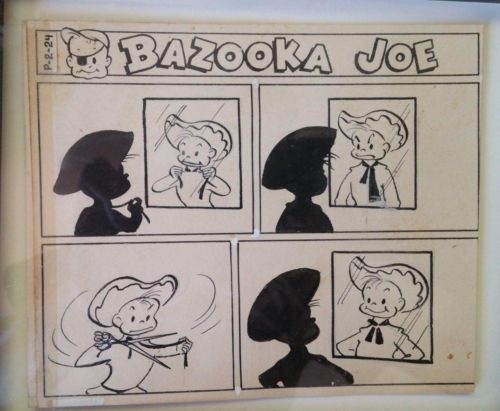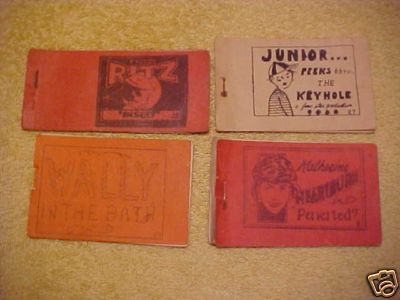Tijuana Bibles
by tom christopher
Tijuana Bibles are self sufficient, self-explanatory. There they are and thats what they are. And thats where the mystery starts.
Tijuana Bibles, also known as 8 Pagers, were probably the first books of new comic character material produced regularly, but because of their nature very little is known about their production and distribution.
One problem is they were purposefully produced anonymously. It was illegal to produce or distribute pornography, and nobody was going to put their name on it. Plus, once sold, anybody with access to a printing press could reprint it.
The reprinting is where a lot of variables come into play. The first variable is the skill of the printers and the nature of their equipment. If a book were a tenth generation reprint that had been done by professional plate makers and printers it could look as good as an original, but a third generation reprint, done by a couple of apprentices on a night shift using scrap paper could look much worse. Paper quality is another variable, and storage was generally not a consideration for these, many having been kept in woodsheds, basements and garages.
By the 1920s girlie joke books such as Capt. Billys Whiz Bang were commonly available on newsstands, and small, almost incomprehensible erotic novels of a dozen or so pages of incoherent English-as-an-imaginary-language text punctuated by grainy explicit photos were available through an underground distribution system. Their typeset covers, printed on a drab olive or grey cardstock often assigned their origin to Paris, France, and outwardly they resemble any small brochure or pamphlet of the period.
The earliest sex comics were smaller versions of these, 8 or 12 pages with typeset covers often identifying Cuba as their source. Their art styles are childish and the drawings have little resemblance to the characters intended. Some of these early books were later reprinted with hand-lettered covers (logo only, no point of origin) and later hand drawn and lettered covers. Some were reprinted using the first page of art for the cover, sans dialogue.
Anthony Woods writes in Comic Strip Tease Volume Two, an early 1970s anthology, that the earliest examples of these were done shortly before the stock market crash of 1929. The final form of approximately 3 x 4 inches with an illustrated cover seems to have developed quickly and to have been perfected by an artist who came to be known as Mr Prolific. It seems as if the earliest examples of this form were printed on one side of slick paper with heavier cardstock covers often beige, blue or pink. The covers and pages in these are single sheets, often rounded on the right side, and the earliest copies date to the 1930s. Oversized books with saddle-stitched binding were also produced during this early period.
Mr Prolific (AKA Squareknob) was prolific indeed. A skilled cartoonist with a style perfectly suited to mimic the great newspaper comics of the day, his books must have looked wickedly contemporary to the audiences of the 1930s. Art Spiegleman, in his introduction to Tijuana Bibles references sexologist Gershon Legman (look him up) in his identification of Doc Rankin as the man behind the pen of probably more books than anyone. Rankin was a cartoonist for Larch Publications between the World Wars and involved in the production of joke, magic and girlie books, and it seems like an easy step for such a company to further the evolution of the form of the Tijuana Bible.
Spiegleman further identifies Wesley Morse as the cartoonist with the light lyrical touch (he calls his line calligraphic) who did the Worlds Fair series, which places them from the late 30s.
Wikipedia identifies Clara Tice as the artist who illustrated Hollywood-themed books such as Nuts To Will Hayes. She also illustrated erotic books in the 1930s and was a friend of Geshon Legman.
Another recognizable artist, from the late 1940s is named Mr Dyslexic by Spiegleman who finds his indifference to craft typical of a general decline in craftsmanship that has marked this centurys progress, and that’s sad indeed when youre discussing a media whose sole intent is to assault common decency. While Im in general agreement as to Mr Dyslixics intelligence theres something about his work I like. Hes obviously a comic book fan, he swipes Simon and Kirby and his panel layouts and line reference comic books, not strips. He knows the second string heroes like Green Arrow, plus I see artistic development from his early work. But keep in mind were discussing the artistic force behind Ah Loves Ya Deer.
In addition, easily recognizable are an artist from the early 1940s who has a style that looks sometimes like linoleum block prints whose design is quite forceful, and the artist of The Private and the Sergeant (among other books) has a style appropriate for joke books or light illustration of the times. In addition I’ve identified one book by Bob Powell, a brilliant commercial comic book artist whose work spans from the earliest days of news stand comics till the late 1960s.
Organized crime may have something to do with their production and distribution. Gerard Jones in his brilliant history of the comics industry Men of Tomorrow, details the connections of organized crime with the early comics publishers, and Will Eisner was offered $3.00 per page to provide art for a client who claimed to have distribution rights for alla Brooklyn (Spiegleman).Tom of Finland told me his work was bootlegged overnight during the 1940s and 50s and a decade later in San Francisco Robert Crumb discovered the same thing, leading the Zap artists to do Snatch Comics and similar gag panel books.
But if organized crime was producing these, they could be bootlegged by anybody. There was money in it, for sure. Spiegleman says they retailed for $.25 – $1.00 and Woods says $1.00 and up, and they could always be resold. Spiegleman mentions books being done with rubber stamps and Ive seen redrawn ditto and mimeographed books (and you can only get 300 copies from a mimeograph stencil). Almost everything is a reprint, and there are variations of everything. I’ve got one containing 20 year old material, obviously bootlegged a hundred times with a new, well drawn cover, printed on strong red paper, to discourage bootlegging.
I recently had an exchange with a person who sold me several, and he wrote: I know that these are from the Baltimore, Maryland area. They were printed, circulated and sold at the Baldwin Locomotive Works between 1938 and 1945. They generated income for a variety of reasons, to pay for union parties, to aid out-of-work co-workers, to put some money into someone’s pocket. They were also purchased by new immigrants who used them for a multitude of uses; to learn the right word in our language for what they needed or wanted (sex), they also learned spelling pronunciation, reading and a whole lot about our culture while their wives and sweethearts were still at home in the old country, continuing that his collection came from an unmarried uncle who worked there, and told him this story. Thats part of what I like about collecting these, theres a wide variety of editions and types of paper and binding, and you really have to be experienced handling paper to have any idea of what youre looking at, and even then, you’ve got to actually at least see a lot before you see the real differences in cover color, paper stock etc.
Woods and Spiegleman both estimate maybe a thousand titles were produced between the very late 1920s and the very early 1950s. Some were released well into the 1960s, parodying such figures as Jackie Onasis and newly popular comic strips such as B.C.
Anthony Woods writes that in 1934 there were only a handful of new and reprint editions available. In 1936 – 37 they were popular, but in late 1937 – 38 they were unpopular, while suddenly becoming very profitable in 1939. He further dates the oversized Erskine Caldwell in Gramps Revenge to an effort to stimulate the industry in 1948, and that the oversized Travelin Preacher went through a successful 4 printings between 1950 and 1953, retailing for $5.00 to $10.00. Mr Woods gives no reference for his figures, which possibly imply more of a central distribution system than may have existed, but theyre interesting, nonetheless. He may have had some connection to the Larch Publishers mentioned above.
The general belief is that the availability of better quality magazines left the old bibles looking quaint. The double sized volumes of the late 1940s may have been indeed an attempt to reinvent the form, but the artists and writers really weren’t up to the task of drawing better or being funnier, and the larger form itself was a contradiction of its clandestine origins, a Tijuana Bible was something to hide, to pass around surreptitiously, and, indeed, they stayed that way. Kept alive by small publishers advertising in the backs of mens magazines, and sold through the mails through the early 1970s they were eventually collected in paperback and hardcover compilations. Brownfield Press continues the tradition today with a high quality series of reprints.
http://brownfieldpress.tripod.com
DOC RANKIN
Ainsworth H Rankin, 1896 -1954 was born in Brooklyn, New York and spent his first six years in England before returning to Brooklyn.
 The city had a very popular newspaper, the Brooklyn Daily Eagle, which carried a children’s section and young Ainsworth received mention for participation in activities and art projects
The city had a very popular newspaper, the Brooklyn Daily Eagle, which carried a children’s section and young Ainsworth received mention for participation in activities and art projects
 He attended Brooklyn Manuel High School, where he was already called ‘Doc’ and known for his cartooning chalk talks.
He attended Brooklyn Manuel High School, where he was already called ‘Doc’ and known for his cartooning chalk talks.
He enlisted in the army in 1916 and served in the Chemical Warfare Service.
At the end of the war he organized a soldier show unit and toured Germany, Belgium and Luxembourg entertaining the troops with his cartoon shop-talks.
After the war he returned to the States and worked as a political cartoonist for the Brooklyn Eagle while also producing commercial art that is known to include post cards, sheet music and cartoons for various joke books, often connected to veteran’s self-help organizations
BIOGRAPHICAL NOTES
|
Doc Rankin apparently stayed in the reserves, and was recalled in 1940 to the Special Services Unit, where he is remembered for his organization in staging the Irving Berlin stage show ‘You’re in the Army’ during it’s American tour and during the filming of the movie.
 He was back in Germany during the Occupation in 1946 – 47, again providing entertainment to the troops with his chalk talks.
He was back in Germany during the Occupation in 1946 – 47, again providing entertainment to the troops with his chalk talks.
 He was stationed in Guam in 1949 and began cartooning for the local newspaper, as well as Stars and Stripes, Pacific Patrol and Fanfare as well as continuing his chalk-talks.
He was stationed in Guam in 1949 and began cartooning for the local newspaper, as well as Stars and Stripes, Pacific Patrol and Fanfare as well as continuing his chalk-talks.
 He achieved the rank of Lieutenant Colonel and died of heart failure at Fort Bragg in 1954.
He achieved the rank of Lieutenant Colonel and died of heart failure at Fort Bragg in 1954.
WESLEY MORSE
Wesley Cherry Morse, 1897 – 1963, was born in Chicago and served in the Army for a year in France before returning to the States and in 1921 he became a regular contributor to magizines such as Film Fun, Snappy Stories and Shadowland. He also did advertising art carried in well-known magazines like Collier’s, Judge and Life.
he worked on several newspaper strips in the 1920s and did at least one comic book story in Circus, the Comic Riot according to the Comic Book Data Base. I found a letter on ebay which details more.
He did Tijuana Bibles in the late 1930s. His simple, lyrical style is classic and his books are always beautiful. His World’s Fair series is well known and was obviously a perfect souvenir for hundreds of tourists. During this time he also did as well as hundreds of gag panels for Larch Publications.
After the war he did advertising work for a number of fashionable nightclubs in New York.
In 1954 created the character Bazooka Joe for the Topps Gum Company and created more than 1000 of the strips for them, as well as numerous non-sports cards.
CLARA TICE
Clara Tice (1888 – 1973) was a bohemian resident of Greenwich Village who was active as a down town artist, but had connections to the uptown Arensberg Circle.
She studied at with Robert Henri of the Ashcan school and was part of the first Independent Artist show. She also knew Marcel Duchamp and contributed to the dada magazine The Blind Man. She played herself in the 1922 version of the Greenwich Village Follies, designed local posters and was known as the Queen of Greenwich Village.
She became notorious when the Society for the Suppression of Vice tried to confiscate her paintings from a Village art show. In the 1940s she became more popularly known for a children’s book about dog breeds.
Her Tijuana Bibles include The various Hollywood themed books.

 Clara Tice was connected during her lifetime to some of the most Avant Garde art movements in the county before Wold War One and was a femnist. Her work is still being displayed in museums and galleries well into the twenty-fist century. In addition to the Tijuana Bibles she also did contemporary magazine and book illustration and a comic for the Protestant World newspaper called Lucy Lou the Kangaroo. The black and white book illustration above is very close to her 8-pager work in spirit and style, and he books are easy to spot.
Clara Tice was connected during her lifetime to some of the most Avant Garde art movements in the county before Wold War One and was a femnist. Her work is still being displayed in museums and galleries well into the twenty-fist century. In addition to the Tijuana Bibles she also did contemporary magazine and book illustration and a comic for the Protestant World newspaper called Lucy Lou the Kangaroo. The black and white book illustration above is very close to her 8-pager work in spirit and style, and he books are easy to spot.
She retired after her last major show, 1934, and became a children’s book artist for a decade before arthritis and glaucoma limited her ability to work. Clara Tice died in Queens New York in 1973 at the age of eighty-five.
MR DYSLEXIC
Name and biography unknown. Mr Dyslexic was named by Art Spiegleman. His work seems to begin in the 1940s, and though crude, he advanced the form of the Tijuana Bible by anchoring the form to comic books, rather than comic strips. He seems to have been a comic fan, as he parodies the second string heroes such as Shining Knight. Mr Dyslexic also did a series of right-winged, politically themed books, one of which, Judith Copolon, would date it to 1949 – 51. These should be noted for their political/current events contents in a generally non-political genre.
One of his last books seems to be Supergirl, who debuted in Action Comics 252, May, 1959.
Mr Dyslexic may still be alive and I would be happy to hear from him, or anyone else directly involved in the production or distribution of Tijuana Bibles
Notes:
Comic Strip – Tease by Anthony Woods
Tijuana Bibles by Art Spiegleman
Guam Frolics by Doc Rankin
Grand Comic Book Data Base
